FOURTEENTH ANNUAL REPORT OF THE MASSACHUSETTS AVIAN RECORDS COMMITTEE
by Marshall J. Iliff and Matthew P. Garvey
originally published in Bird Observer
The fourteenth report of the Massachusetts Avian Records Committee (hereafter MARC or the Committee) details the evaluation of 66 reports involving 47 species or subspecies. Fifty-two records were accepted.
One new species has been added to the State List in the current report, a Pink-footed Goose (Anser brachyrhynchus), documented in Falmouth in January 2009. (A 1999 report of Pink-footed Goose in Dennis is being re-reviewed.) This brings to 492 the total list of species accepted for Massachusetts. Other highlights from this report include the first physically documented Black-capped Petrel (Pterodroma hasitata) and Black-tailed Gull (Larus crassirostris) records for the Commonwealth; the fifth confirmed United States record of Brown-chested Martin (Progne tapera); the first state records of Ivory Gull (Pagophila eburnea) since 1985; and a record-shattering four records of Ross’s Goose (Chen rossii) involving eighteen birds.
The list of species reviewed by the MARC (the “Review List”) is available at www.maavianrecords.com/review-list, the Committee’s new Internet address. Several changes to the Review List were made at the Committee’s February 2010 annual meeting. First, Audubon’s Shearwater (Puffinus auduboni) and Long-tailed Jaeger (Stercorarius longicaudus) were removed because both have now been proven to occur regularly in Massachusetts’ offshore waters. Although the jaeger may occur in offshore waters anywhere, the shearwater apparently is restricted to the warm, deep water south of Nantucket and Martha’s Vineyard; the Committee will continue to review any reports from outside these species’ normal ranges. The MARC has also edited its Review List for consistency. It will now review all Tufted Duck (Aythya fulvigula) and Curlew Sandpiper (Calidris ferruginea) reports, regardless of the bird’s sex and age.
The Committee will continue to review certain records of rare birds at the non-species level as well, such as records of distinctive subspecies or subspecies groups. While MARC has long reviewed subspecies reports at its discretion, this year its policy was formalized with a change to the MARC bylaws which provides that “[r]ecords of species or other taxa (e.g., subspecies, genera) that are geographically or temporally rare will be evaluated at the discretion of the Committee.” The MARC Review List was updated accordingly to mirror the new language in the bylaws. The Committee is careful to keep such review at its discretion, and continues to only list full species (sensu AOU 1998) on its Review List. In this report six records have been accepted at the subspecies level.
The bylaws were also amended to mandate an automatic recirculation whenever a first round of ballots is not unanimous. This change ensures that all members of the Committee will gain the benefit of any dissent, even if the initial voice in the wilderness is a lone one. The voting standards remain stringent; on the second and third rounds, a record needs the support of all or all but one member in order to gain acceptance. All accepted records in this report were accepted unanimously on the first round unless noted.
Most submissions are now accompanied by photographic evidence, signaled in the species accounts below with a “ph.” Indeed, for many of this year’s records, no formal submission was made, but the Committee was able to accept a record based solely on the photographic (ph.), video (v.) or audio (au.) record made public through such useful resources as Massbird.org and the myriad photo-sharing Internet services. The Committee continues to encourage written submissions (signaled below with a “†”), even where photographs exist. Written submissions often provide important clues to identification (such as behavior) or provenance that even an exquisite suite of photos may not. One need not be the original finder to make a submission. MARC’s primary objective in assessing reports is weighing evidence. The observer names in parentheses refer only to those who provided documentation; the names are followed by the MARC record number. In addition, when known, we try to credit the discoverer either in the text or with an asterisk (*) if he or she supplied evidence. All documentation received by the Committee is maintained permanently in the Committee archives. In the near future, MARC plans to make the supporting evidence for accepted records publicly available on its website.
Recent advances in digital photography and video have made it easier and less expensive to obtain and store high quality documentary evidence. The concomitant increase in data has provided both opportunities and challenges to the MARC. While modern photography has greatly increased the number of unequivocally documented records, it cannot eliminate falsified or dishonest submissions. It goes without saying that the ability of avian records committees like ours to assess bird records, whether based on written descriptions, photographs, or other documentation, is dependent upon honest submissions from the birding community. Computer technology has perhaps made it easier for submissions to be “faked” in a compelling manner and has therefore increased the risk that MARC could be duped. Indeed, one of the records in this report represents the first instance (that we know of) where a sighting was reported to the MARC in a dishonest fashion. Fortunately the record was clarified before voting occurred, which in this case led to the report’s failure to gain acceptance, and factored into the failure of other reports where the same individual was the lone observer. We hope this instance will be the last of its kind, but unfortunately we will need to remain vigilant to protect the integrity of Massachusetts records.
In an effort to provide more specific locality information for each record, this report now lists the location, town, and county (in italics). Offshore waters within MARC’s purview are those in the ocean region defined by the median line between Massachusetts and the nearest point of land outside the state, and extending 200 miles offshore (Rines 2009). Species taxonomy and nomenclature follows the seventh edition of the AOU Checklist (AOU 1998) and supplements (e.g., Chesser 2009). Each species is listed with its scientific name the first time it is mentioned in the text, but not thereafter. Subspecies nomenclature follows the Clements Checklist of Birds of the World (version 6.4) taxonomy, available at http://www.birds.cornell.edu/clementschecklist.
Finally, the Committee wishes to extend its warmest and most sincere thanks to retiring MARC secretary, Marj Rines, for her unflagging involvement and support of the MARC practically since the Committee’s inception. As secretary, Marj devoted more than ten years to the substantial processes of filing, archiving, prodding (!), and tabulating votes and various other critical duties. In fact, she is responsible for most of the records in the current report. Marj developed and maintained the MARC website and record database, thereby moving the Committee forward into the digital and Internet age. She produced the last ten annual MARC Reports. Her efforts are especially notable because she also successfully led other critical initiatives for the Massachusetts birding community, including the seasonal reports and database maintenance for Bird Observer, maintaining the popular Massbird.org website, and assuming a leadership role in the Menotomy Bird Club. Accordingly, the Committee wishes Marj all the best in her many continuing roles, which contribute so much to Bay State ornithology.
Late in 2009 Matt Garvey succeeded Marj Rines as secretary. The 2009 roster of MARC voting members was: Jeremiah Trimble (Chair), Denny Abbott, David Clapp, Richard S. Heil, Marshall J. Iliff, Erik Nielsen, Wayne R. Petersen, James P. Smith, and Robert Stymeist. For 2010, Iliff replaced Trimble as Chair, and Trevor Lloyd-Evans, Blair Nikula, and Richard R. Veit replaced Abbott, Nielsen, and Trimble, whose terms expired. We thank them for their service as voting members and thank Trimble for serving three years as MARC chair, for establishing the new MARC website, and for supplying many of the statistics for this report. We also thank Nielsen and Naeem Yusuff for valuable assistance with the MARC website and database, and for helpful comments on this report.
ACCEPTED RECORDS
Pink-footed Goose (Anser brachyrhynchus)
This report kicks off with its only addition to the state list, an adult Pink-footed Goose discovered by Greg Hirth at Salt Pond, Falmouth, Barnstable, January 12–15, 2009 (ph. B. Burden; †G. Hirth*; 2009-10). The goose showed no signs of captivity and was traveling with a flock of wild Canada Geese (Branta canadensis). An earlier Massachusetts record from the vicinity of the Dennis Pines Golf Course, Dennis, Barnstable, January 16–February 20, 1999, was considered of “questionable origin” (1999-24; Rines 2002), in part due to the bird’s confiding behavior. Pink-footed Geese are rarely kept in captivity, and their numbers in the Northeast have been increasing steadily since the mid-1990s; this increase has been concurrent with a rise in the breeding population in Greenland (Perkins 1998). Occurrences of other Greenland-breeding geese have been on the rise as well (e.g., Barnacle Goose Branta leucopsis and “Greenland” Greater White-fronted Goose Anser albifrons flavirostris), and so it no longer seems appropriate to continue the conservative treatment of Pink-footed Goose records. In light of this change in status, the MARC is currently reconsidering the 1999 record.
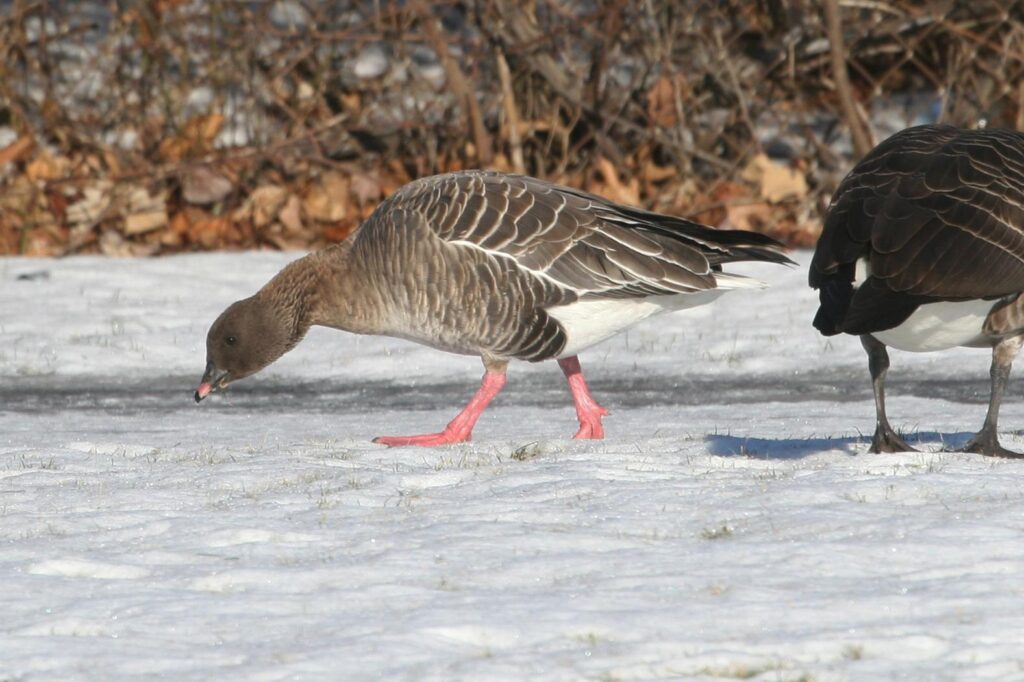
Adult Pink-footed Goose at Salt Pond, Falmouth, Barnstable, 14 Jan 2009. This represented Massachusetts’s first accepted record; like most vagrant geese, it is an adult. Photo by Barry Burden.
“Richardson’s” Cackling Goose (Branta hutchinsii hutchinsii)
A flock of seven adults that split its time between Plum Island and Ipswich, Essex, November 7–14, 2009, represents the second largest flock recorded of this species in Massachusetts (†J. Berry*, ph. P. Brown, ph. N. Landry, †T. Wetmore*; 2009-36); a group of nine at Turner’s Falls, November 27–December 2, 2007, was the only higher count. At least one bird was present starting on October 31, 2009, though it was not clear if that bird was part of the flock of seven; one Committee member felt a total of eight Richardson’s Cackling Geese were present during the period. Another Committee member noted that the distinctive blocky head shape evident on each bird in a photo of seven birds together was classic for the expected Richardson’s subspecies, but urged caution because he felt that photos of the lone bird may have indicated a form of “Lesser” Canada Goose (e.g., Branta canadensis parvipes).
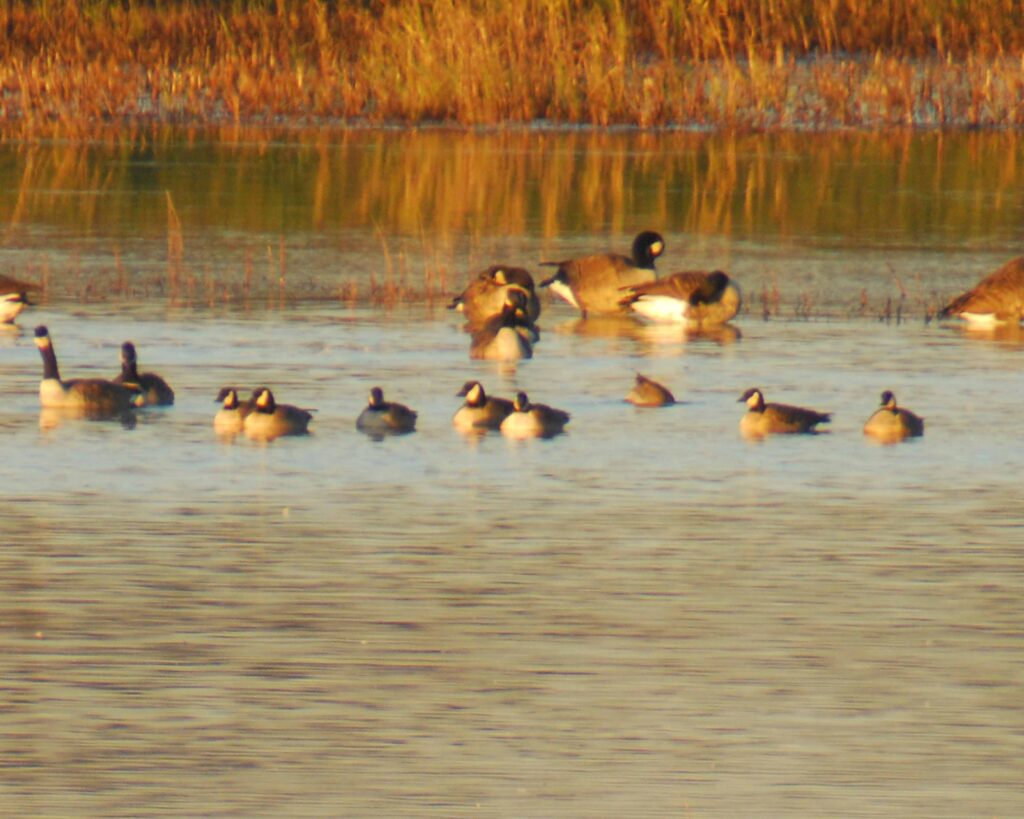
Though distant, this photo captures well the size and unique head shape of these seven adult “Richardson’s” Cackling Geese on Plum Island, Essex, 7 Nov 2009. Photo by Nancy Landry.
Ross’s Goose (Chen rossii)
March 2009 produced an unprecedented incursion of Ross’s Geese in multiple flocks. The Ross’s records began with a state high count of seven at Argilla Road, Ipswich, Essex, March 15, 2009 (ph. P. Brown, ph. R. Heil*, ph. M. Iliff, †T. Wetmore; 2009-06), although others had seen seven white geese there on March 14 but did not identify them as Ross’s. Although the seven birds remained together, some observers noted that they sometimes separated into two sub-groups: apparently a family (two adults and three first-winters) and a pair (two adults). The flock remained through March 23, 2009, and during this time was seen also on Plum Island, a well-known alternate location for geese using Argilla Road. The day after the initial report of the Ipswich flock, eight adults in Easthampton, Hampshire, March 16–18, 2009, set a new state high (†R. and L. Beida*, ph. J. van Heerden; 2009–04); five seen in Hadley March 20–22, 2009 (NAB 63:391), were presumably part of this same flock, but were not reviewed by the Committee. Two more adults were found in the vicinity of Kimball Farm, Haverhill/West Newbury, Essex, March 19–28, 2009 (ph. †S. Mirick*; 2009-05). Finally, an immature seen on Plum Island March 22–30, 2009 (ph. N. Landry, ph. J. Trimble, †T. Wetmore; 2009-07), was known to be a different bird because on March 23 Tom Wetmore observed eight birds together, with the group of seven departing for Ipswich while a lone immature stayed behind. The end date for the latter bird is listed as March 31 (NAB 63:391), but this is apparently in error. Ross’s Goose has been increasing in the East for two decades now, and records from eastern New England have been on the rise in the past eight years. Interestingly, a flock of 17 “Western” Greater White-fronted Geese (Anser albifrons frontalis) also made an appearance in Saugus/Revere, Essex/Suffolk, March 7–15, 2009 (NAB 63:391), suggesting that a single phenomenon affected several taxa of geese wintering mid-Continent. Roberts (2009) places the 2009 records in context, noting that a number of Ross’s were seen east of their normal range in spring 2009, including one in Maine and several on Prince Edward Island. Perkins (2009) goes further, providing weather maps suggesting that strong southwesterlies on March 6–13, 2009, were likely responsible for the eastward displacement of these geese and several other species. Prior to this year Massachusetts had just three records of Ross’s Goose: two at Sunderland, Franklin, March 25–26, 1997 (Petersen 1998); one immature at Chilmark, Dukes, October 14–22, 2001 (Rines 2002; note that this report erroneously considers this bird an adult); and one at Barton’s Cove, Gill, Franklin, October 21–23, 2004 (Rines 2006). When evaluating out-of-range Ross’s Geese, the Committee is careful to eliminate the very real possibility of Snow Goose (Chen caerulescens) x Ross’s Goose hybrids; at least one such bird has been reported in Massachusetts, in the Newburyport area, Essex, November 9–27, 1999. The Committee is gathering information on this record, as putative hybrids pose difficult identification issues.
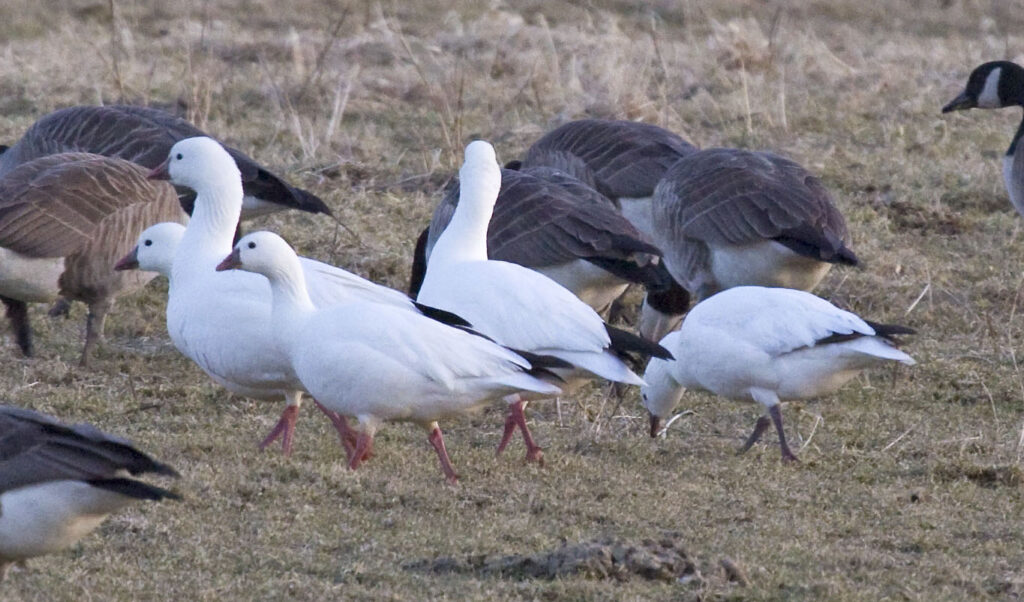
Group of Ross’s Geese at Argilla Rd., Ipswich, Essex 16 Mar 2009. The three immatures were essentially identical to the adults in plumage and even bill color, so the duller leg color and dark shaft streaks on the tertials of the immatures were the best characters for ageing. In this image, the four leftmost birds are adults and the rightmost bird is an immature. Photo by Marshall J. Iliff.
Barnacle Goose (Branta leucopsis)
One was discovered by Tom French at Orlando’s Ponds, Charleton, Worcester, December 3–13, 2008 (†M. Lynch, ph. †S. Carroll; 2008-36). Although older records of Barnacle Goose often considered the birds to have possibly escaped from human confinement, the recent upsurge in records, consistent timing for state reports (usually October–December), and occurrence with flocks of migratory Canada Geese (and occasionally other species like “Greenland” Greater White-fronted or “Richardson’s” Cackling Geese), have contributed to the current understanding that most Barnacle records in New England pertain to wild birds. Thus, this Charleton record passed unanimously on its first round, and no member showed strong reservations about the bird’s provenance.
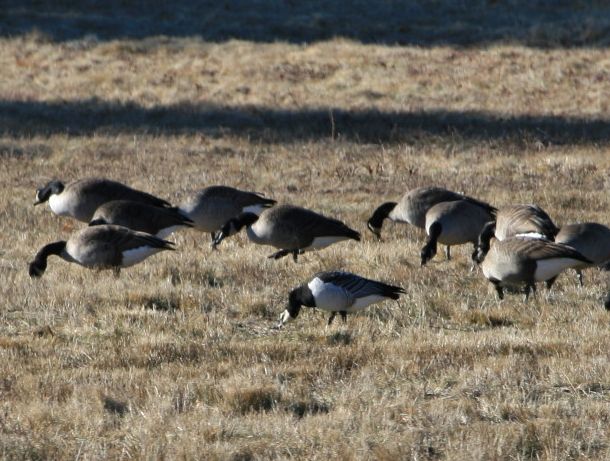
One of these geese is not like the others! Adult Barnacle Goose at Orlando’s Ponds, Charleton, Worcester, 13 Dec 2008. Photo by Sheila Carroll.
“Eurasian” Green-winged Teal (Anas crecca crecca)
A single male “Eurasian” Green-winged Teal at Thompson’s Meadow, Salem, Essex, April 14, 2008 (ph. †C. Jackson*; 2008-27), was found during peak spring migration of “American” Green-winged Teal (Anas crecca carolinensis), matching the pattern of most Massachusetts records of the Eurasian form. The Committee reviews subspecies selectively, and while the Committee opted to review this report, “Eurasian” Green-winged Teal is probably regular enough in the state (one to four records per year) to not warrant review.
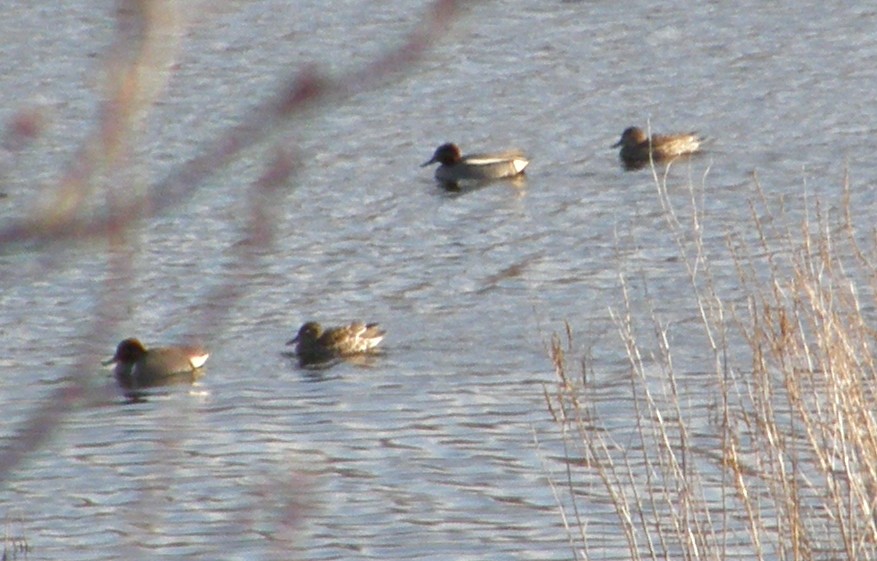
This comparison shot captures the horizontal white stripe on this “Eurasian” Green-winged Teal at Thompson’s Meadow, Salem, Essex,14 Apr 2008. Photo by Craig Jackson.
“Boreal” Common Eider (Somateria mollissima borealis)
The Committee considered a report of an adult male “Boreal” Common Eider (Somateria mollissima borealis) from Bass Rocks, Gloucester, Essex, on January 2–4, 2008 (ph. †M. Iliff*; 2008-34). Although not reflected in the MARC record, Jeremiah Trimble also observed this bird at the same location on February 3, 2008. Useful field marks that separated this bird from S. m. dresseri (the expected subspecies in Massachusetts waters) included bill process ending in a point, bill color orange or yellow-orange rather than greenish, white face with greenish color restricted to rear of face, and head shape with steep forehead and flat top. In addition, the black along the lower margin of the bill process was even, rather than wedge-shaped. Intermediates occur (e.g., Beetz 1916, Mendall 1980, Griscom and Snyder 1955), so this taxon should be identified with caution, but this record appeared to involve a bird matching pure borealis. This form of Common Eider breeds in Greenland and on the Somerset and Ellesmere Islands, Nunavut, south to Southampton Island, Hudson Strait, and northern Labrador, and occurs regularly in winter in Newfoundland and Nova Scotia (Johnsgard 1979, AOU 1957). Reports in the Northeastern United States are few. If we pay more attention to winter eider flocks, it may prove to be regular, but to date we are aware of just five other reports from Massachusetts: one bird shot at Muskeget on March 15, 1980; one shot at Newburyport on November 16, 1933 (both Veit and Petersen 1993); one found dead at Martha’s Vineyard on June 16, 1946 (Chalif 1947); an adult male at Provincetown, Barnstable, December 28, 2006–early January 2007 (ph. J.P. Smith et al.); and an adult male in Gloucester Harbor on January 2, 2007 (ph. D. Pavlik, et al.). It is probably regular in small numbers in northern Maine, and several, along with several intergrades, have recently been found each year in southern Maine (D. Lovitch, L. Bevier pers. comm.). It is also known from Connecticut (AOU 1957) and New York (Bull 1974). Much remains to be learned; for more information, see Goudie, et al. (2000), Scott (1957), Mendall (1986), and Knapton (1997).
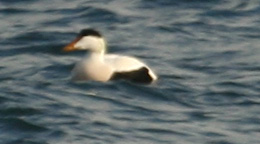
Adult male “Boreal” Common Eider, Bass Rocks, Gloucester, Essex, 2 Jan 2008. See the text for an in depth discussion of the field marks for this taxon, which is probably more regular in Massachusetts than the few records would indicate. Photo by Marshall J. Iliff.
Pacific Loon (Gavia pacifica)
One adult in breeding plumage photographed off Manomet Point, Manomet, Plymouth, on June 7, 2009 (ph. †I. Davies*; 2009-21), added to the growing number of reports of adults from May and early June and suggests a spring passage during this period. The one dissenting member felt that rather distant photos did not eliminate the possibility of an Arctic Loon (Gavia arctica). See also records not accepted.
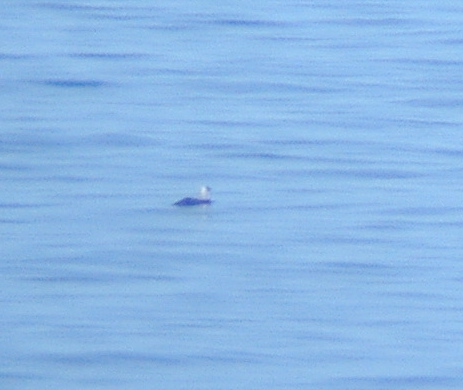
Loons can be difficult to review, so fortunately this Pacific Loon in alternate plumage off Manomet Point, Manomet, Plymouth, 7 Jun 2009, was photographed by Ian Davies.
Black-capped Petrel (Pterodroma hasitata)
Annual deep-water pelagic trips by the Brookline Bird Club have recently turned up a number of interesting records. In 2009, the best find was a single Black-capped Petrel about 15 miles northwest of the head of North Atlantis Canyon and about 77 miles south of Martha’s Vineyard (40.170833° N, 70.758333° W) on July 18, 2009 (ph. †J.P. Smith*, ph. †J. Trimble*; 2009-18). It was seen by all aboard, and the photos make this the first physically documented record for Massachusetts. A recent paper (Howell and Patteson 2008) suggests the existence of two distinct plumage types of Black-capped Petrels, which they refer to as “Black-faced” and “White-faced” forms. Although it is yet unclear whether these represent different morphs, subspecies, or species, three Committee members commented that this individual was a good match for Howell and Patteson’s white-faced form of Black-capped Petrel. Massachusetts has two prior accepted records of Black-capped Petrel: one at Andrew’s Point, Gloucester, Essex, October 25, 2005 (2005-38; Petersen 1995), and one at South Sunken Meadow Beach, North Eastham, Barnstable, August 19, 1991 (1991-02; Rines 2007). A third record is currently accepted from Stellwagen Bank, April 22, 1991 (1991-01; Petersen 1995), but the Committee is re-reviewing that record in light of the very real possibility that the photos show a Bermuda Petrel (Pterodroma cahow). Another reported from Race Point, Provincetown, Barnstable, June 23, 2009, has yet to be reviewed.
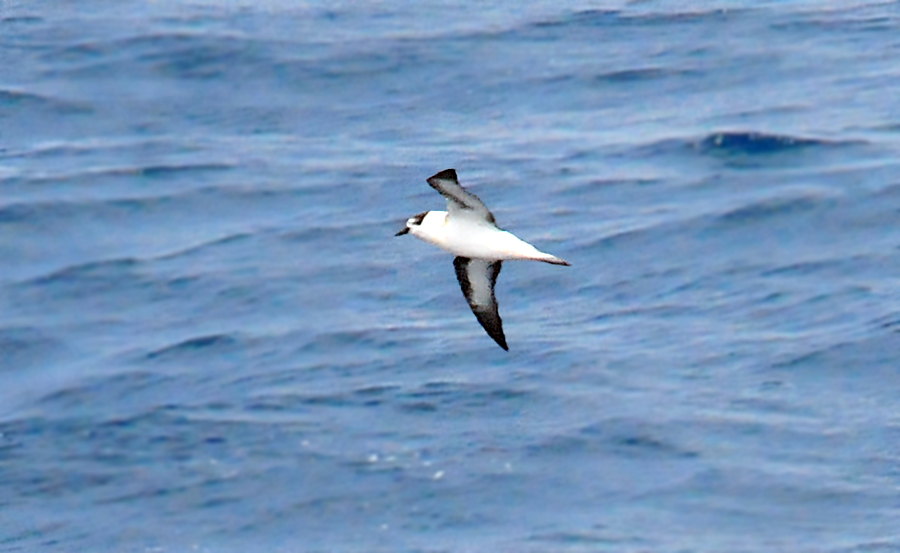
Black-capped Petrel about 77 mi south of Martha’s Vineyard 18 Jul 2009. Note the extensively pale face and restricted cap, matching the recently-described “white-faced” form. This represents the first photographed record for Massachusetts. Photo by Jeremiah Trimble.
White-faced Storm-Petrel (Pelagodroma marina)
On a boat only ten to fifteen miles south-southwest of Nantucket (41.05216° N, 70.3975° W) on August 28, 2009, Peter Trimble and Vernon Laux discovered this charismatic species and captured a dazzling suite of diagnostic photos (ph. P. Trimble*, ph. V. Laux*; 2009-35). Committee members speculated that the species is regular in Massachusetts waters in late summer—perhaps regular enough to consider not reviewing the bird in the future, something sea-worthy birders would surely have fun trying to establish.
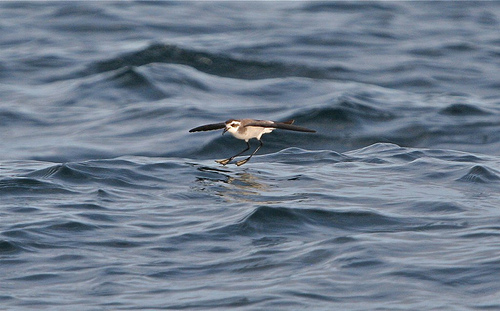
Want a reason to get out on the high seas? White-faced Storm-Petrel is now proving to be regular in waters to the south of Nantucket, with this bird not far south of Nantucket on 28 Aug 2009 being one of the most recent records and best documented. Photo by Peter Trimble.
American White Pelican (Pelecanus erythrorhynchos)
Three at Gooseberry Neck, Westport, Bristol, November 15, 2009 (†D. Eastman*; 2009-08), were described to the Committee’s satisfaction. One member noted that Great White Pelican (P. onocrotalus), which has been found as an escapee on the East Coast, was not eliminated, but was satisfied that a record of three birds together must pertain to American White.
Wood Stork (Mycteria americana)
A golfer found a hatch-year bird on the Duxbury Yacht Club Golf Course, Duxbury, Plymouth, November 3, 2009 (ph. J. Carnuccio*; 2009-29), and fortunately used his Blackberry to snap some photos of this distinctive species, which was not reported after the day of its discovery. Of Massachusetts’ eight Wood Stork records, three are from November; one additional November record of eleven birds at Plymouth Beach, Plymouth, November 18, 1963, has not gained general acceptance and may be reviewed by MARC.
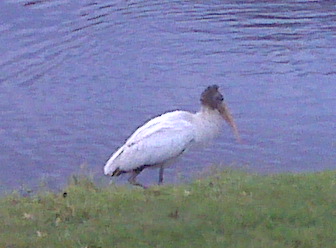
You don’t always need a fancy camera to establish a rarity. Here a Blackberry sufficed to document this immature Wood Stork at the Duxbury Yacht Club Golf Course, Plymouth, 3 Nov 2009. Photo by John Carnuccio.
Swallow-tailed Kite (Elanus forficatus)
Two Swallow-tailed Kites seen over Harmony Lane, Brewster, Barnstable, on May 10, 2009 (†D. Clapp*; 2009-17), constituted a remarkable number for one location, and the state high count. The record was submitted as three birds, and while four Committee members accepted it as such, the majority felt the careful description of the sighting and circumstances did not sufficiently establish that three birds were present. The timing was typical; most Swallow-tailed Kites in Massachusetts occur from late April to late May.
Gyrfalcon (Falco rusticolus)
One apparent brown morph at Plum Island, Essex, November 27– December 3, 2008 (†D. Chickering*, ph. T. Wetmore; 2008-32), proved difficult for the Committee. It passed (8-1) on its second round, due in part to the addition of photographs by Tom Wetmore from December 3. Extremely distant, the photos were not considered diagnostic by all members; those in support of the identification noted the apparent falcon shape, large size, dark color, and long tail relative to the wings.
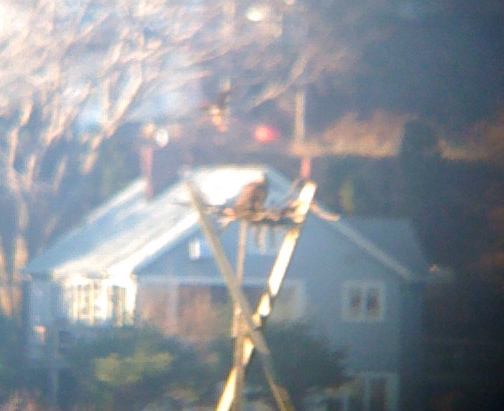
Not universally considered diagnostic, this distant photo of a Gyrfalcon at Plum Island by Tom Wetmore 3 Dec 2008 helped bolster a written submission.
“Arctic” Dunlin (Calidris alpina arctica)
Another distinctive yet seldom reported subspecies considered by the Committee this year was the diminutive “Arctic” Dunlin. A July 29, 2007, visit to South Beach, Chatham, Barnstable, was highlighted by an odd hybrid sandpiper believed to be a White-rumped Sandpiper x Dunlin (Calidris fuscicollis x alpina) and by an unusually small, dull-colored Dunlin in full-breeding plumage. The latter bird was identified as C. a. arctica (ph. M. Garvey*, ph. †M. Iliff*; 2007-56) based on its short bill, buff-gold back color, reduced black belly patch, and small size relative to nearby first-summer Dunlin, which were presumably C. a. hudsonia, the only expected subspecies of Dunlin on the East Coast (although C. a. alpina was collected once at Monomoy; Griscom 1937). Although a small number of first-summer Dunlin may oversummer in Massachusetts, mid-summer Dunlins are rare, and breeding-plumaged birds in fall migration are very rare because C. a. hudsonia molts to basic plumage prior to its southbound migration. “Arctic” Dunlin, in contrast, migrates before molting and also migrates much earlier, so any breeding-plumaged Dunlin seen in Massachusetts from July to September should be carefully scrutinized and documented. C. a. schinzii is the other smaller subspecies of Dunlin and also molts after migration, but has a richer chestnut back. Both C. a. arctica and C. a. hudsonia share rather faint breast streaking, as compared to other Dunlin subspecies. C. a. arctica was collected once in Massachusetts, from Monomoy, on August 11, 1900 (Griscom 1937). Although there have been other sight records thought to pertain to this subspecies, this record may represent just the second confirmed occurrence in the AOU area. The Committee plans to review the other Massachusetts record as well.
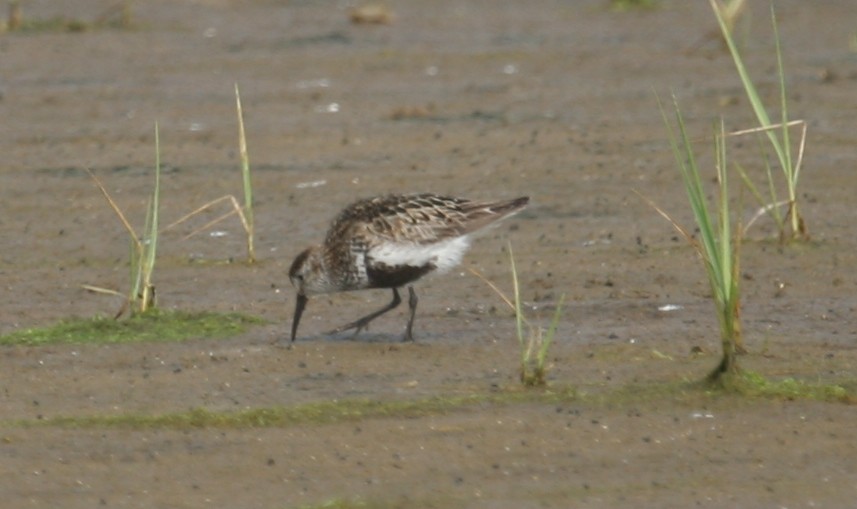
“Arctic” Dunlin (Calidris alpina arctica) at South Beach, Chatham, Barnstable, 29 Jul 2007; the reduced black belly patch, dull upperparts, and rather short bill are apparent in this image. Photo by Marshall J. Iliff.
Ivory Gull (Pagophila eburnea)
One of the premier birding events of 2009 was the first Massachusetts appearance of Ivory Gulls in 24 years. Jeremiah Trimble found the first on the breakwater at Eastern Point, Gloucester, Essex, January 17–22, 2009 (ph. †J. Trimble*; 2009-01), and the cooperative adult was seen by hundreds during its stay in the area, which ultimately included wanderings as far inside the harbor as Jodrey Fish Pier. Amazingly, three days later, Barry Burden discovered a second adult at Plymouth Harbor, Plymouth, Plymouth, January 20–30, 2009 (ph. B. Burden*, †J. Hanson, ph. †P. Kinnaly; 2009-02), which was similarly cooperative. Both birds were seen concurrently on some days, eliminating any doubt that two different birds were involved. Massachusetts had 12 or 13 prior records of Ivory Gull, all from 1886–1985 (with a possible earlier specimen from Swampscott in the mid-1800s). The most recent was one at Plum Island, Essex, February 2–3, 1985 (Bird Observer 13 [3], 157), although this record has not been reviewed by MARC. Interestingly, of the ten prior records with known age, all but one pertained to a first-winter bird.
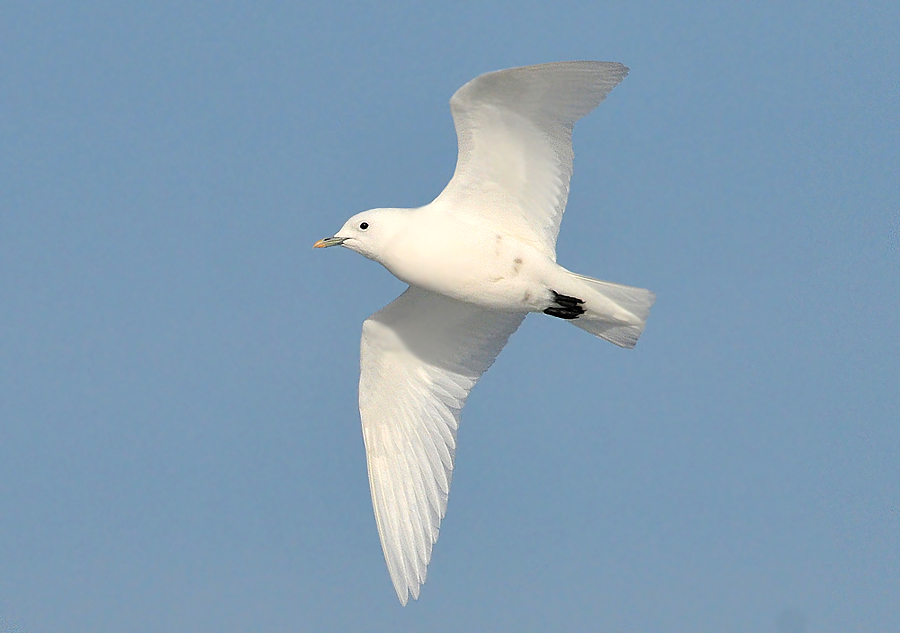
Adult Ivory Gull at Eastern Point, Gloucester, Essex 17 Jan 2009-the first for Massachusetts in more than two decades. Photo by Jeremiah Trimble.
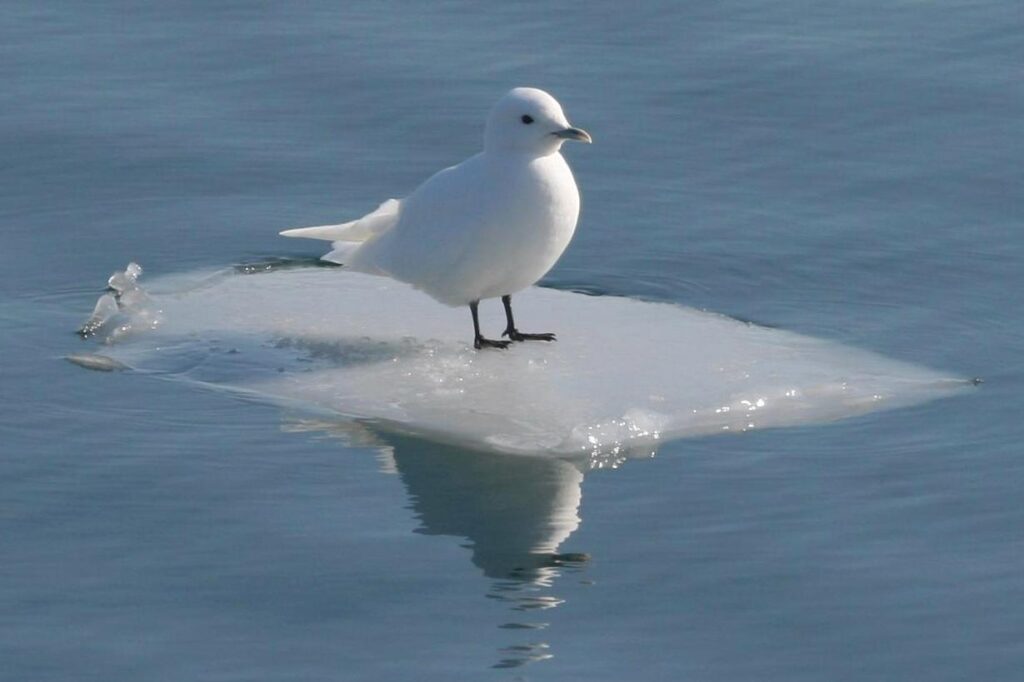
And this adult Ivory Gull at Plymouth Harbor, Plymouth, Plymouth, 20 Jan 2009, followed closely on its heels! Photo by Barry Burden.
Franklin’s Gull (Larus pipixcan)
One second-winter or adult at Sandy Point State Reservation, Plum Island, Essex, on November 15, 2008 (ph. †R. Heil*; 2008-29), was found among a concentration of gulls in the late afternoon and was well-photographed.
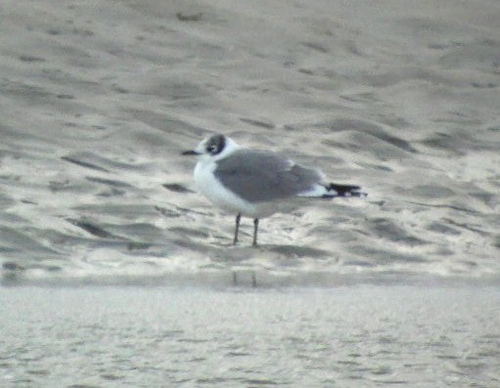
The distinctive half-hood and dainty bill of this Franklin’s Gull were well-captured in this photo by Rick Heil, 15 Nov 2008.
Black-tailed Gull (Larus crassirostris)
One adult at Herring Cove, Provincetown, Barnstable, November 1–7, 2008 (ph. †B. Nikula*; 2008-33), represented the first state record to be physically documented. The only prior accepted state record resulted from a single observer sighting of one at South Beach, Chatham, Barnstable, July 4, 2004 (Rines 2006). There are at least twelve additional reports for the East Coast, from Newfoundland (one), Nova Scotia (one bird that returned for several years to Sable Island), Rhode Island (one returned for three years), New York (two), New Jersey (one), Maryland (two), Virginia (three+ records including one returning for several years to the Chesapeake Bay-Bridge Tunnel), and North Carolina (one). See also records not accepted.
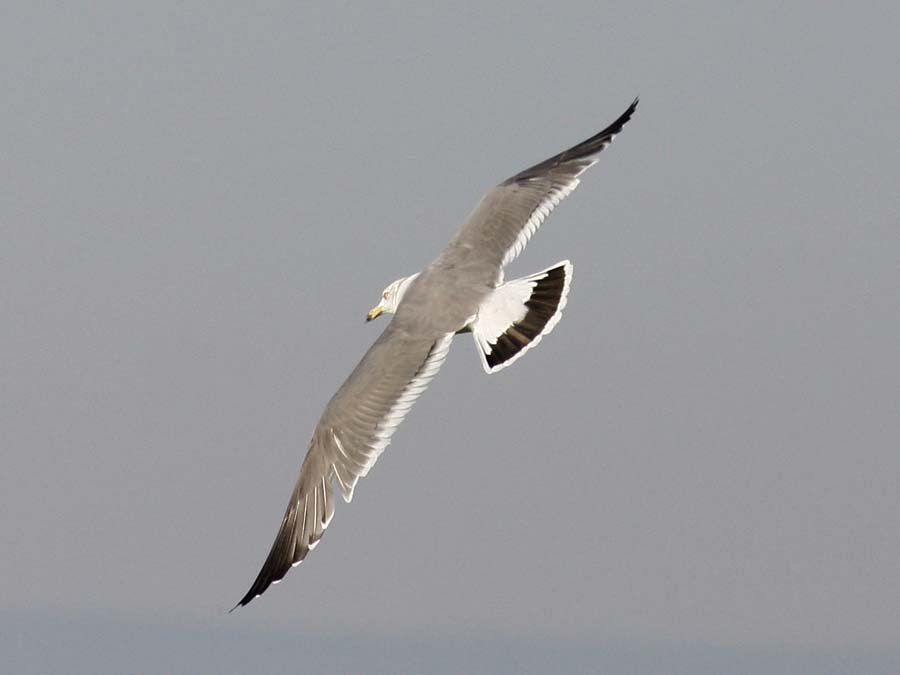
Adult Black-tailed Gull at Herring Cove, Provincetown, Barnstable 1 Nov 2008. Distinctive in flight, this individual furnished a second state record and was the first to be physically documented in Massachusetts. Photo by Blair Nikula.
Thayer’s Gull (Larus thayeri)
Thayer’s Gull has been found with increasing frequency in Massachusetts in recent years, due to more awareness of this species as well as excellent gull-watching in the Gloucester area. One first-winter bird at Hellcat, Plum Island, Essex, on March 14, 2009 (ph. †J. Trimble*; 2009-15), was well-photographed, and the Committee was convinced that it was not a “Kumlien’s” Iceland Gull (Larus glaucoides kumlieni). Identification (and Committee review) of Thayer’s Gull is fraught with peril, given the uncertainty surrounding the extent of its introgression with kumlieni, the acceptable variability in those two taxa, and the taxonomic status of each. Thus, while the Committee supports this record and others as fitting known characters for thayeri, we acknowledge that further study may shed new light on this especially enigmatic field problem, which may prompt reassessment of any or all Massachusetts records of Thayer’s Gull. See also reports not accepted.
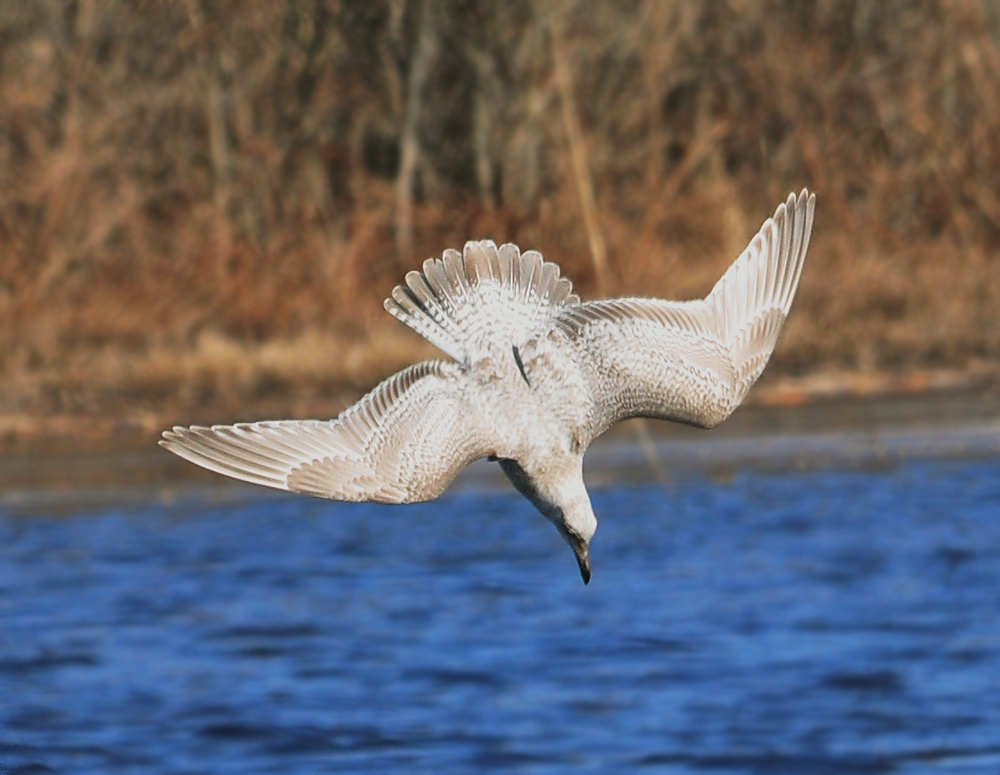
Taxonomic issues notwithstanding, when trying to document a Thayer’s Gull you can’t get much better than this image by Jeremiah Trimble at Plum Island, Essex, 14 Mar 2009.
Bridled Tern (Onychoprion anaethetus)
Bridled Tern is probably regular in small numbers over the deep water canyons of the Continental Shelf in July, August, and September. One apparent adult was at Hydrographer Canyon (39.970278° N, 69.520556° W) on September 10, 2008 (†T. Stephenson*, ph. †S. Whittle*; 2008-37).
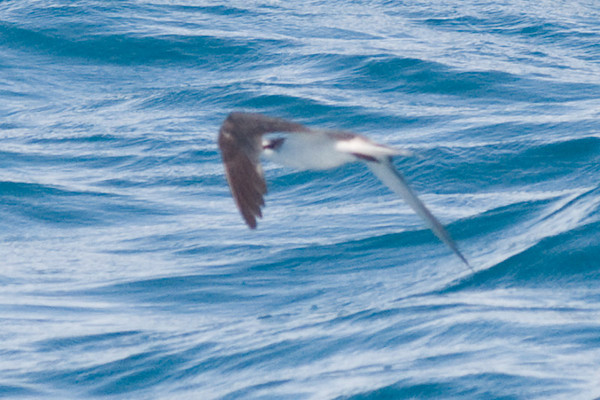
This Bridled Tern at Hydrographer Canyon was headed away but not fast enough to escape capture by Scott Whittle, 10 Sep 2008.
Sooty Tern (Onychoprion fuscatus)
Photos of a bird found moribund at Smith’s Point, Nantucket, on September 7, 2008 (ph. V. Laux; 2008-44), depicted a dark tern with white-spotted blackish upperparts and white underwing coverts, diagnostic of juvenile Sooty Tern. The bird died the following day, and the specimen was deposited at the Maria Mitchell Association.

A rare opportunity to capture the distinctive underwing of a juvenile Sooty Tern in Massachusetts. Photo by Vernon Laux, 7 Sep 2008.
South Polar Skua (Stercorarius maccormicki)
“Now this is the kind of skua report I like!” exclaimed one Committee member in voting to accept this species within a taxonomically tricky family that poses notorious difficulties for records committees. A bird seen on August 15, 2007 (ph. †A. Wilson*; 2007-57), at 41.30375° N, 69.29946° W, was especially interesting because the bird was banded and the band could be read in the photos. The band code indicated that the bird was banded by a team from Friederich Schiller University in a mixed Brown (S. hamiltoni) and South Polar skua colony on King George Island (62.2° S, 58.97° W) in the South Shetland Islands on February 9, 2005; it was believed to be a phenotypically pure South Polar Skua when banded (fide Marcus Ritz), and the Committee concurred with that determination based on the photos. This was possibly just the second banded South Polar Skua to be recovered in the North Atlantic (the previous one was from Greenland, July 31, 1975). Interestingly the same team from Friederich Schiller University had banded a hybrid South Polar x Brown Skua that was later recovered off the Flemish Cap in Greenland. This event should prompt caution in future identification and review of southern hemisphere skuas in the North Atlantic. See also records not accepted.
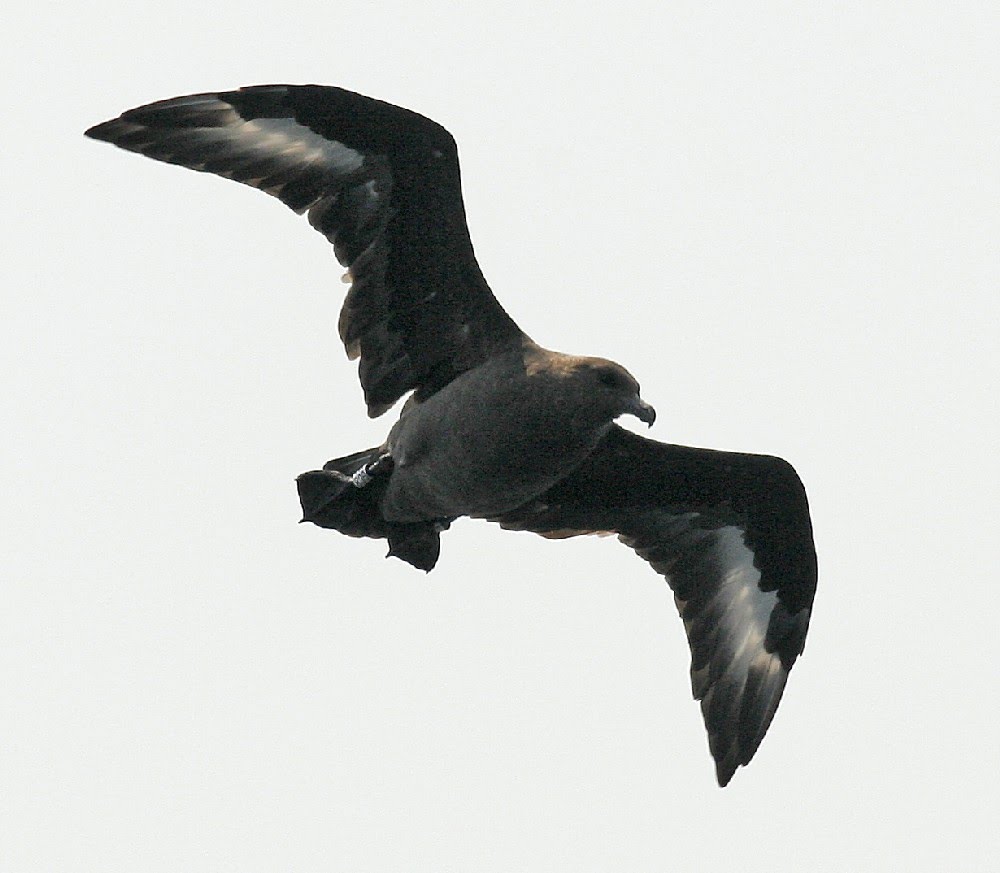
Martha’s Vineyard 15 Aug 2007. The band visible in this photo helped
confirm the identification and traced the origin of the bird to King George Island. Photo by Angus Wilson.
Black-backed Woodpecker (Picoides arcticus)
This boreal bird was found by Lori Snell and identified by Edie Ray on April 25, 2009 (ph. J. Trimble; 2009-33), although it may have been present in the Pitch Pines (Pinus rigida) at Mass Audubon’s Lost Farm, Nantucket, as early as April 15, 2009. It lingered until at least May 17, 2009, and while at times it was hard to find, diagnostic and exquisite photos of this male were taken.
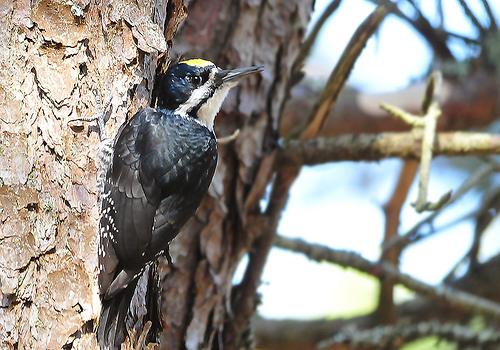
Lost Farm, Nantucket’s, month-long visitor Black-backed Woodpecker was a male, as evidenced by the yellow cap seen in this 26 Apr 2009 photo by Jeremiah Trimble.
White-winged Dove (Zenaida asiatica)
One adult at a Manomet feeder, Plymouth, August 6–12, 2009 (ph. I. Davies*; 2009-20), fortuitously turned up at the home of Ian Davies, who was ready with his camera. Several other observers were able to visit and see this bird as well. Massachusetts has 27 records of White-winged Dove, and in 2009 an unusually high total of five, most of which the Committee has yet to review.

It pays to watch your feeder birds carefully! This White-winged Dove at a Manomet, Plymouth backyard 6-12 (here 6) Aug 2009. Photo by Ian Davies.
Rufous Hummingbird (Selasphorus rufus)
Rufous Hummingbird records in Massachusetts and the Northeast continue to increase. One adult female at Hyannis, Barnstable, December 7–30, 2008, was banded on December 9 (ph. †S. Finnegan; 2008-35) and carefully measured to eliminate Allen’s (S. sasin). The other, at a S. Yarmouth, Barnstable, feeder on September 9, 2009 (ph. A. Middleton*; 2008-25), was reported to eBird (www.ebird.org), and upon inquiry the reporter provided stunning close-ups of a rufous-backed adult male.

Careful feather analysis and measurements helped nail this adult female Rufous Hummingbird in Hyannis, Barnstable, 7-30 (here 9) Dec 2008. Photo by Sue Finnegan.

This photo of a full-gorgeted adult male Rufous Hummingbird in S. Yarmouth, Barnstable, 9 Nov. 2008, came to light during an eBird inquiry. Photo by Anne Middleton.
Selasphorus sp. (Selasphorus sp.)
Photos of a female/immature Selasphorus sp. at a Leicester, Worcester, yard October 7–8, 2008 (ph. †M. Rowden*; 2008-26), confirmed the identification at the genus level. At its February 2010 annual meeting, the MARC decided to try for higher specificity, and will re-review all records of Selasphorus sp. to clarify whether Broad-tailed Hummingbird (Selasphorus platypterus) can be eliminated and whether the record can be listed as Rufous/Allen’s Hummingbird.
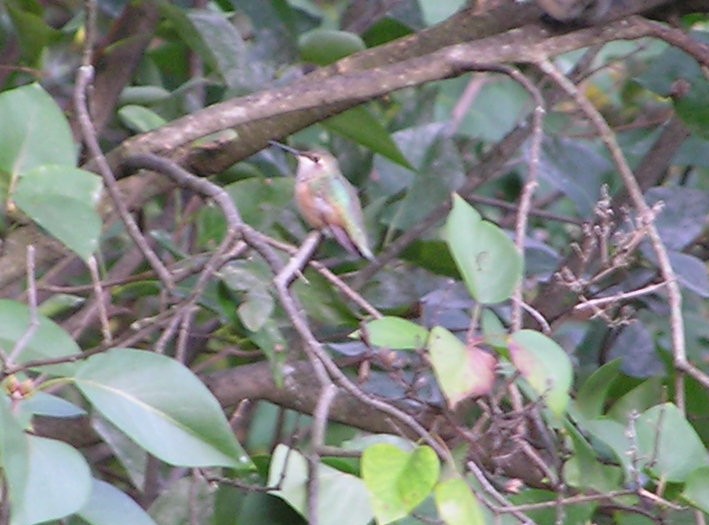
Selasphorus sp. at Leicester, Worcester, 8 Oct 2008. Although some Committee members felt it was certainly a Rufous/Allen’s Hummingbird, the Committee did not formally assess this but plans to do so in the future. Photo by Mark Rowden.
Say’s Phoebe (Sayornis saya)
A Say’s Phoebe spent September 13–14, 2009, at Keith Farm, Chilmark, Martha’s Vineyard, Dukes, (ph. L. McDowell; 2009-32), long enough to allow for diagnostic photos. The bird was apparently in its hatch-year, as evidenced by its fluffy down feathers and rather bold wing bars.

Hatch-year Say’s Phoebe at Keith Farm, Chilmark, Martha’s Vineyard, Dukes, 14 Sep 2009. Photo by Lanny McDowell.
Fork-tailed Flycatcher (Tyrannus savana)
This distinctive species was seen near the Coskata-Coatue Wildlife Refuge, Nantucket, Nantucket, May 7, 2009 (†D. Lang*; 2009-19), and was described to the satisfaction of eight Committee members; the one dissenter opined that Eastern Kingbird (Tyrannus tyrannus) had not been eliminated.
Gray Jay (Perisoreus canadensis)
Although documented by written description only, a Gray Jay at the Moran Wildlife Management Area, Windsor, Berkshire, on January 1, 2009 (†J. Bishop*; 2009-11), was in the expected part of the state and was well documented with descriptions of the species’ dark crown, pale forehead, short bill and pale auriculars, thereby eliminating Northern Shrike (Lanius excubitor) and Northern Mockingbird (Mimus polyglottus).
Brown-chested Martin (Progne tapera fusca)
A Brown-chested Martin at Cumberland Farms near the Middleboro/Halifax line, Plymouth (v. M. Garvey, ph. R. Heil, ph. M. Iliff*, ph. H. Levesque, ph. J. Trimble*; 2009-23), was plucked from an exceptionally large and diverse collection of swallows independently by both Marshall Iliff and Jeremiah Trimble on October 12, 2009. It lingered until October 14, 2009, and delighted dozens with its distinctive bow-winged aerial displays. Superb diagnostic photos captured the stream of dark spotting extending to the belly, indicating that the bird was of the migratory southern South America subspecies P. t. fusca. Other swallows present at the same time included four Cliff (Petrochelidon pyrrhonata), four Bank (Riparia riparia) and one Rough-winged (Stelgidopteryx serripennis), all unusually late, along with the expected smattering of Barn (Hirundo rustica), and hundreds of Tree swallows (Tachycineta bicolor). The martin represented the fifth accepted record for the United States and the second for Massachusetts, the prior being a bird at South Monomoy, Barnstable, on June 12, 1983, and that specimen had been confirmed also as P. t. fusca (Petersen et al. 1986, Rines 2009). The other three accepted United States records are as follows: one P. t. fusca at Cape May, NJ, November 6–15, 1997 (Lehman 1998); one at Groton, New London, CT, July 1, 2006 (NAB 60:507; Kaplan and Hanisek 2008) was likely P. t. fusca (not P. t. tapera as reported by ABA (2008)); and one photographed at Patagonia Lake, Santa Cruz, AZ, February 3, 2006 (NAB 60:270). An additional sighting of one from near Goose Lake Prairie, Grundy, IL, June 30, 2007, that was well described by a very experienced observer (T. S. Schulenberg, pers. comm.), and another at Belle Glade, Palm Beach, FL, October 24, 1991 (Langridge and Hunter 1993), have not been accepted by the respective state records committees, but the latter was treated as hypothetical by Stevenson and Anderson (1994). P. t. fusca breeds in southern South America south to central Argentina, winters in northern South America, and occurs north to central Panama during the austral winter, April to September (Ridgely and Gwynne 1989).
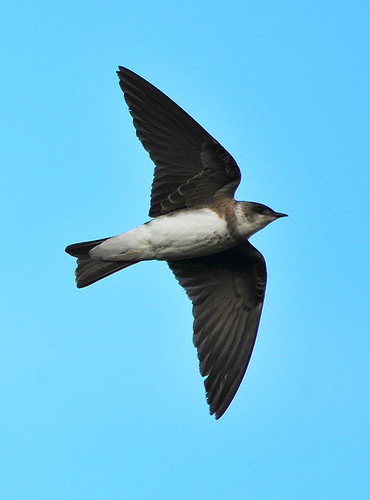
Brown-chested Martin at Cumberland Farms near the Middleboro/Halifax line, Plymouth, 14 Oct 2009. The dark spotting extending to the belly confirms it as the migratory subspecies from southern South America. Photo by Jeremiah Trimble.
Cave Swallow (Petrochelidon fulva)
Since its first accepted occurrence in November 2003, Cave Swallow has now come to be expected during strong cold fronts in November. The Committee reviewed and accepted three records from November 2008. One bird seen at Millennium Park, West Roxbury, during strong NW winds (and a strong flight of finches and other land birds) on November 11, 2008 (†M. Garvey*; 2008-22), provided a first record for Suffolk. On the same day, another one was at Sandy Point State Reservation, Plum Island, Essex (ph. R. Heil, †S. Sutton*, †T. Spahr*; 2008-23). Finally, one was seen at West Island, Fairhaven, Bristol, on November 16, 2008 (†R. Stymeist*; 2008-39), as it flew westward along the shore. The south shore of Cape Cod and the Bristol coastline may be the best area for seeing the species in the state, although this area receives relatively sparse coverage from birders. As has come to be expected for these November occurrences, in each instance plumage was typical of the western subspecies P. f. pallida, although the Committee did not formally vote on these records at the subspecies level. In addition to these three records, 11 additional reports from November 2008, involving at least 52 individual birds, have yet to be reviewed by MARC.
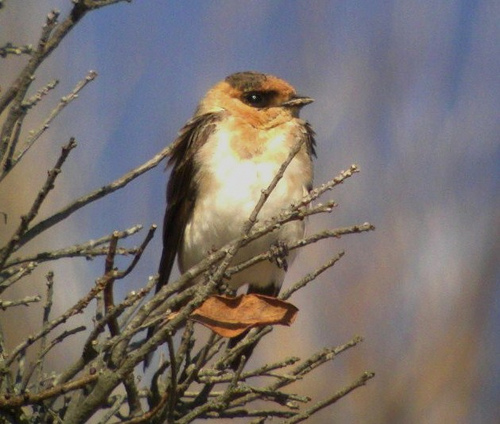
Cave Swallow (P. f. pallida) at Sandy Point State Reservation, Plum Island, Essex, 11 Nov 2008. Photo by Rick Heil. The rather pale throat that strongly contrasted with the chestnut forehead patch is typical of subspecies pallida, and eliminates the darker-throated Caribbean subspecies.
Mountain Bluebird (Sialia currucoides)
One female at Fort Hill, Eastham, Barnstable, November 23–December 7, 2008 (ph. M. Faherty, †B. Parker*; 2008-30), was well-documented with photographs. This represented just the sixth record for the state.
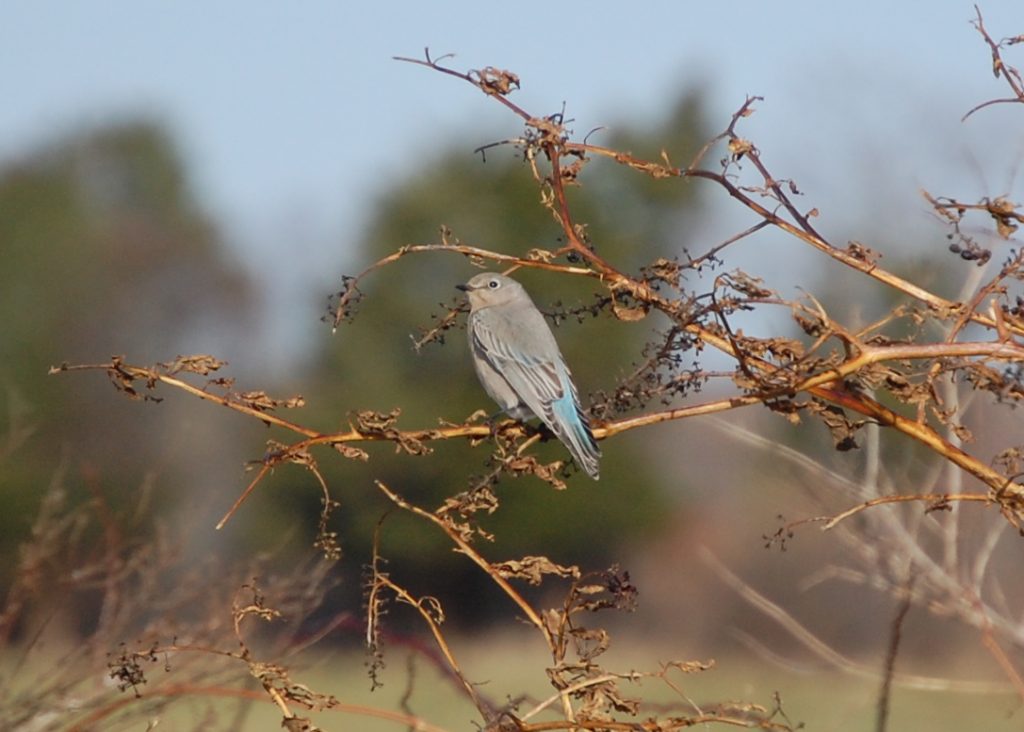
Female Mountain Bluebird at Fort Hill, Eastham, Barnstable, 24 Nov 2008. Photo by Mark Faherty.
Varied Thrush (Ixoreus nivosus)
One hatch-year male found at the intersection of Eastern Point Boulevard and Fort Hill Avenue, Gloucester, Essex, on October 26, 2008 (ph. R. Heil*; 2008-28), represented the earliest record (by three days; Veit and Petersen 1993) for Massachusetts. The winter of 2008–2009 was an excellent one for this species in New England, with at least seven records from Maine, two from New Hampshire, one in Connecticut, and one additional Massachusetts bird at Palmer, April 24–26, 2009 (NAB 63:231,396); the latter report has yet to be reviewed by MARC.
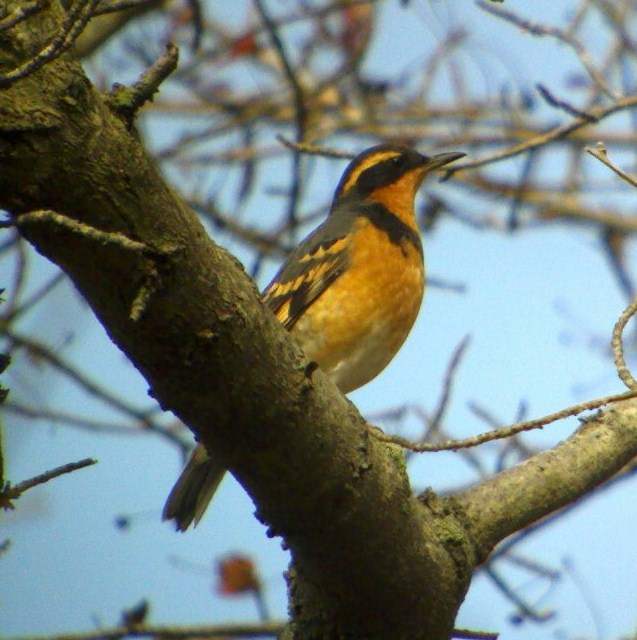
Male Varied Thrush, Eastern Point Boulevard and Fort Hill Avenue., Gloucester, Essex, 26 Oct 2008. Photo by Rick Heil.
Magnolia Warbler (Dendroica magnolia)
One at the Boston Public Garden, Boston, Suffolk, on December 1, 2007 (†C. Floyd*; 2007-49), was reviewed because it represented a record late date for Massachusetts; Veit and Petersen (1993) list November 27 as the previous latest record for the state. Although some six species of late warblers, including Black-throated Green (Dendroica virens), Pine (Dendroica pinus), Nashville (Vermivora ruficapilla), and multiple Orange-crowneds (Vermivora celata), were present at the Public Garden during this period, a Magnolia on this date was exceptional. The somewhat brief description by a single observer failed to convince one Committee member on the third round circulation, but the other eight were convinced by the described field marks, especially the description of bold black flank streaking and white tail with a black tip.
Townsend’s Warbler (Dendroica townsendi)
One adult male at Chestnut Hill Reservoir, Boston, Suffolk, April 14–19, 2009 (ph. E. Nielsen, ph. D. Romps*; 2009-03), was interesting in that the bird was first reported as a Magnolia Warbler, a species with similar heavy black flank streaking. Although some individuals were skeptical because a Magnolia Warbler would have been exceptional on so early a date, it was not until David Romps found a Townsend’s Warbler in the same location on April 17 that the subject of the original report became clear. This cooperative warbler remained three days after being correctly identified and was seen by dozens. Another Townsend’s Warbler was a hatch-year bird captured, banded, measured and photographed (by cell phone!) at Wing Island, Brewster, Barnstable, on November 7, 2009 (ph. †G. Putonen*; 2009-34); it was relocated on November 9 by Mary Keleher.
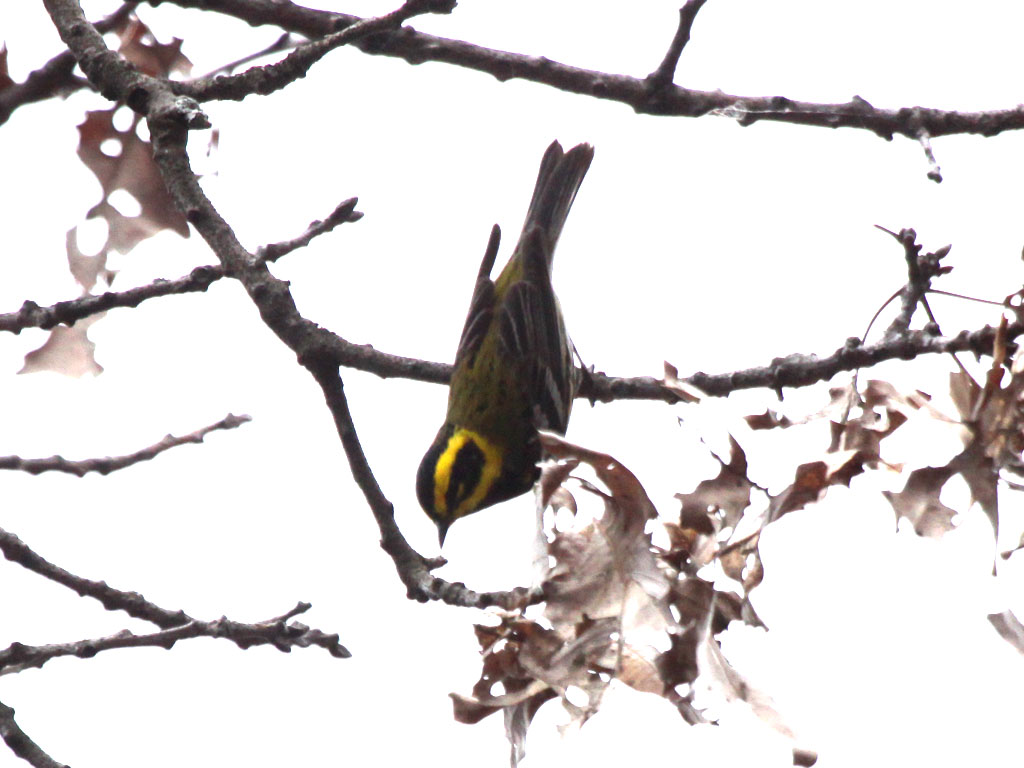
Adult male Townsend’s Warbler at Chestnut Hill Reservoir, Boston, Suffolk, 18 Apr 2009. Photo by Erik Nielsen.
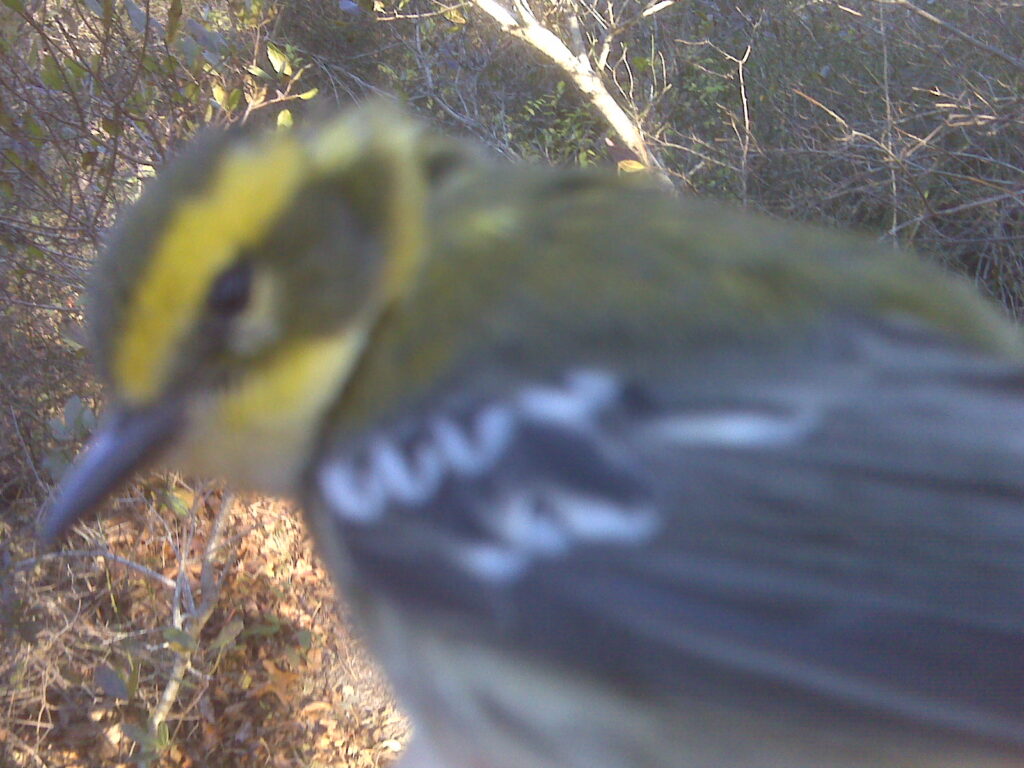
A cell-phone camera sufficed to snap diagnostic photos of this Townsend’s Warbler at Wing Island, Brewster, Barnstable, 7 Nov 2009. Photo by Gretchen Putonen.
MacGillivray’s Warbler (Oporornis tolmei)
Massachusetts remains the hotspot in eastern North America for this handsome western warbler, with two more records in 2009. Paul Peterson found the first in the shadows of Fenway Park at the Victory Gardens in Boston, Suffolk, an obliging bird that entertained birders from November 17 through December 16, 2009 (v. M. Garvey, †P. Peterson*, ph. R. Stymeist, ph. J. Trimble; 2009-30). The second, at Wright’s Pond in Medford, Middlesex, November 21–December 14, 2009 (ph. J. Forbes, ph. A. Piccolo*; 2009-31), was harder to document but still allowed for diagnostic photos. Of 24 records from East Coast states from Maine to North Carolina, 16 are from the Commonwealth, and two are from Fenway’s Victory Gardens. See also records not accepted.
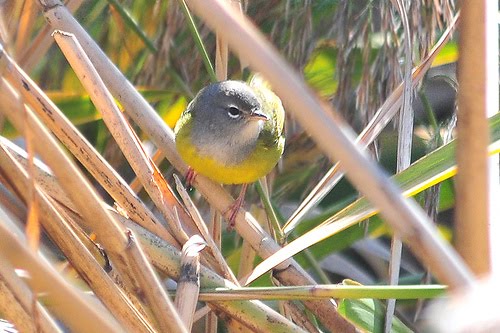
MacGillivray’s Warbler, 18 Nov 2009, Victory Gardens in Boston, Suffolk. Photo by Jeremiah Trimble.
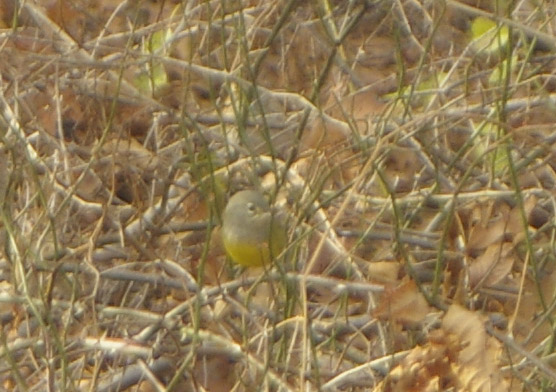
MacGillivray’s Warbler, 21 Nov 2009, Wright’s Pond, Medford, Middlesex. Photo by Anna Piccolo.
Lark Bunting (Calamospiza melanocorys)
It was fitting that Jim Sweeney should discover one of the fall season’s multiple megas at his local patch, Cumberland Farms, Middleboro/Halifax, Plymouth, an immature Lark Bunting that remained over a month, November 4–December 13, 2009, and allowed for multiple diagnostic photos (ph. E. Nielsen, ph. †W. Petersen; 2009-27).
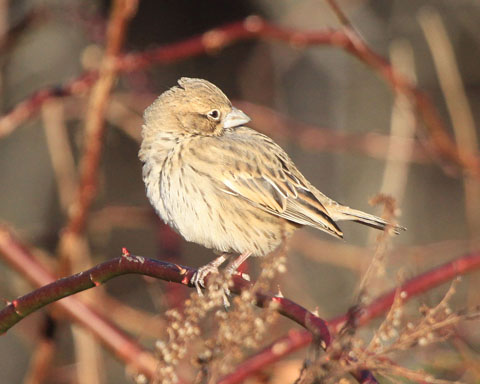
Lark Bunting, 12 Dec 2009, Cumberland Farms, Halifax/Middleboro, Plymouth. Photo by Erik Nielsen.
Henslow’s Sparrow (Ammodramus henslowii)
Two Henslow’s Sparrows made 2009 an exceptional year for this elusive Ammodramus sparrow. Mark Fairbrother found a singing male in Montague, Franklin, June 27–July 8, 2009 (v. M. Garvey, ph. P. Manship; 2009-25); it was well-photographed, and the song was recorded on video. The other sighting was a one-day wonder by Paul Champlin at Allen’s Pond in Westport, Bristol, on November 16, 2009 (ph. L. Miller-Donnelly; 2009-26). There have been only five records of Henslow’s Sparrow since 2000; at one point it had been a rare breeder in the Commonwealth.
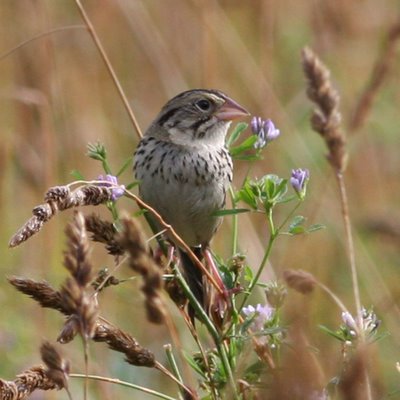
Henslow’s Sparrow, Montague, Franklin, 8 July 2009. Photo by Peter Manship.

Henslow’s Sparrow, Allen’s Pond in Westport, Bristol, 16 Nov 2009. Photo by Laura Miller-Donnelly.
Le Conte’s Sparrow (Ammodramus leconteii)
Another highlight in a banner fall season at Cumberland Farms in Halifax/Middleboro, Plymouth, was a surprisingly cooperative Le Conte’s Sparrow that lingered from October 20–November 9, 2009 (v. M. Garvey, ph. M. Iliff*, ph. R. Merrill, ph. E. Nielsen; 2009-24). It afforded scores of birders killer looks at a cryptic species. Diagnostic, close-up photos and a video showed juvenal feathers, indicating that this was a hatch-year bird. Perhaps under-reported because most individuals do not reveal themselves as readily as this one, it represented only the third record since 2000.
Le Conte’s Sparrow, 26 Oct 2009, Cumberland Farms, Halifax/Middleboro, Plymouth. Video by Matthew Garvey.
Golden-crowned Sparrow (Zonotrichia atricapilla)
One photographed visiting a backyard feeder in South Natick, Middlesex, on April 18–19, 2009 (ph. †P. Loranger*; 2009-09), represented the twelfth state record. There have been eight sightings in April, with the rest between October and January.
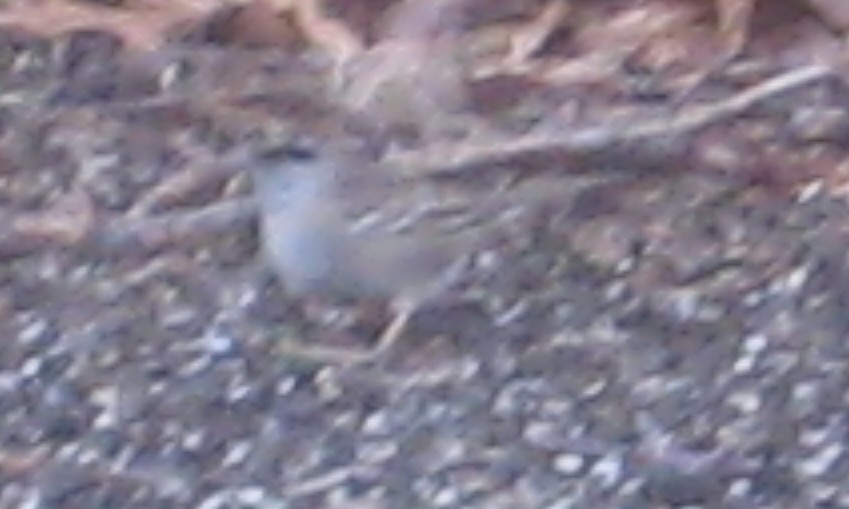
Fuzzy, but sufficient to clinch the record of this Golden-crowned Sparrow, South Natick, Middlesex, 18 Apr 2009. Photo by P. Loranger.
Black-headed Grosbeak (Pheucticus melanocephalus)
One apparent female photographed at a Beverly, Essex, feeder between November 30, 1957 and May 9, 1958 (ph. L. B. Smith; 1957-01), was widely seen at the time, and thankfully a photo of the bird munching on a sugared donut was located to establish the record. Given the difficulty of eliminating a first-winter male Rose-breasted Grosbeak (Pheucticus ludovicianus), which can have rich orange on the breast, the Committee took three rounds to arrive at a decision. On the third round, the Committee unanimously agreed that although there was just a single photo, it showed the following diagnostic field marks: 1) bright orange breast with limited, fine streaking restricted to the sides; 2) buff-orange collar; and 3) a buff-orange rump. The latter is not widely mentioned as a Black-headed Grosbeak field mark, but specimen review by the Committee at the Harvard Museum of Comparative Zoology confirmed it as a valuable distinctive characteristic.
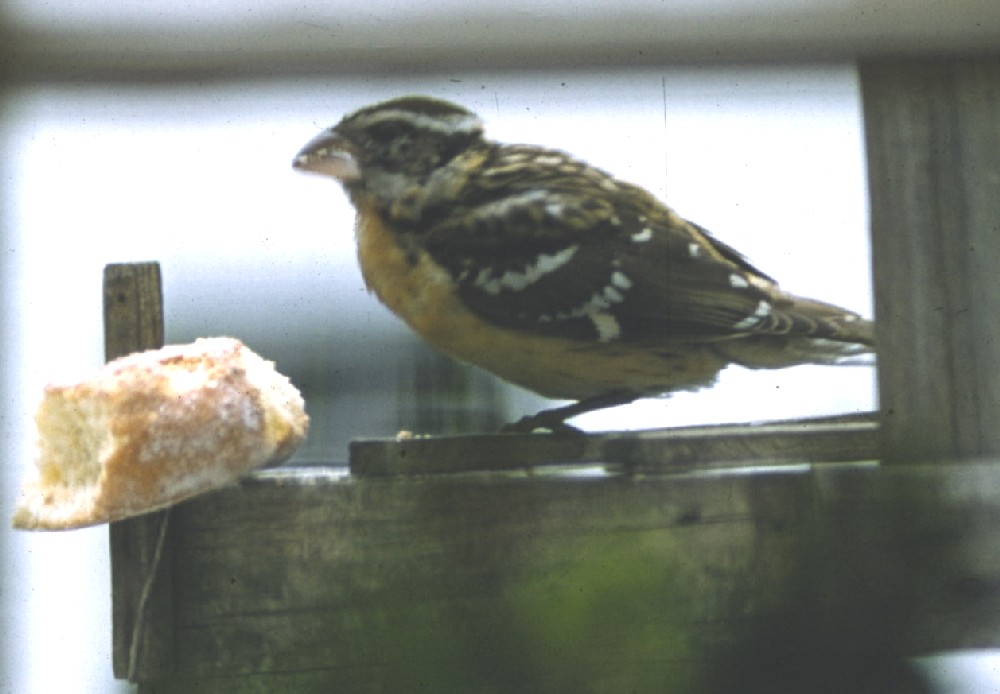
Black-headed Grosbeak at Beverly, Essex, 8 Dec 1957. A faintly paler rump showing in this image was helpful for eliminating a first-winter male Rose-breasted Grosbeak. Photo by Leighton Smith.
A submission of six Hoaries from a feeder in Millbury, Worcester, December 15, 2007–February 24, 2008 (ph. †D. Berard*; 2007-39), during a well-documented invasion year for both Common and Hoary Redpolls, caused problems for the Committee in terms of voting on how many birds were present. In a third round of voting, the Committee accepted at least two Hoary Redpolls. Some birds were submitted as being of the nominate hornemanni subspecies, but the Committee did not accept any birds as such. Low numbers of recaptures reported by West et al. (1968) suggest that while Hoary and Common redpoll (A. flammea) numbers may appear constant at a site, there is actually substantial turnover among birds, and some members noted that perhaps many individuals were present. Nonetheless, despite a plethora of photos submitted to support the record, Committee members felt they could not determine anything more than that “two or more” Hoary Redpolls were present. Generally, when submitting reports of multiple birds, a detailed accounting of the plumages and documentation for each individual bird is highly recommended. See also records not accepted.
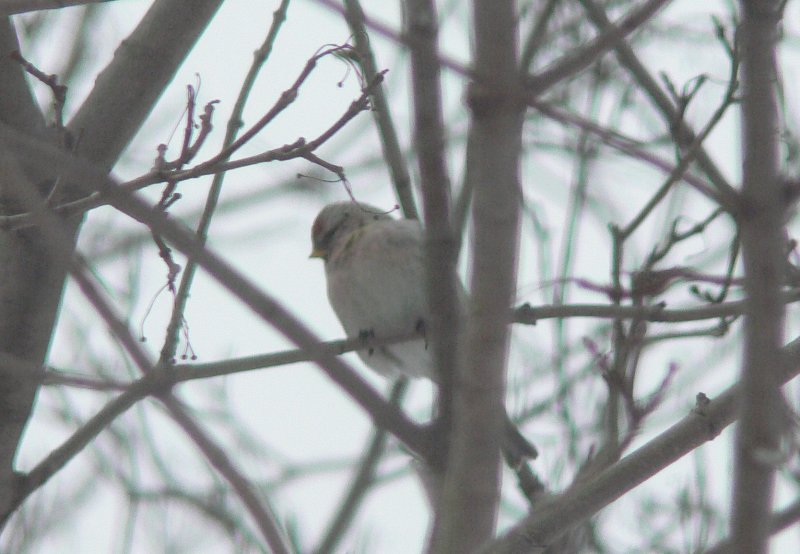
Hoary Redpoll, Millbury, Worcester, 17 Jan 2008. Photo by Dan Berard.
“Greater” Common Redpoll (Acanthis flammea rostrata)
The Committee accepted that one of the Common Redpolls at a feeder in Millbury, Worcester, on December 20, 2007 (ph. D. Berard*; 2007-46), was of the large, thick-billed and dark “Greater” or “Greenland” subspecies (Acanthis flammea rostrata). It took three rounds for the Committee to settle on a number; ultimately, while one member believed two birds were present, the other members voted for the presence of one bird.
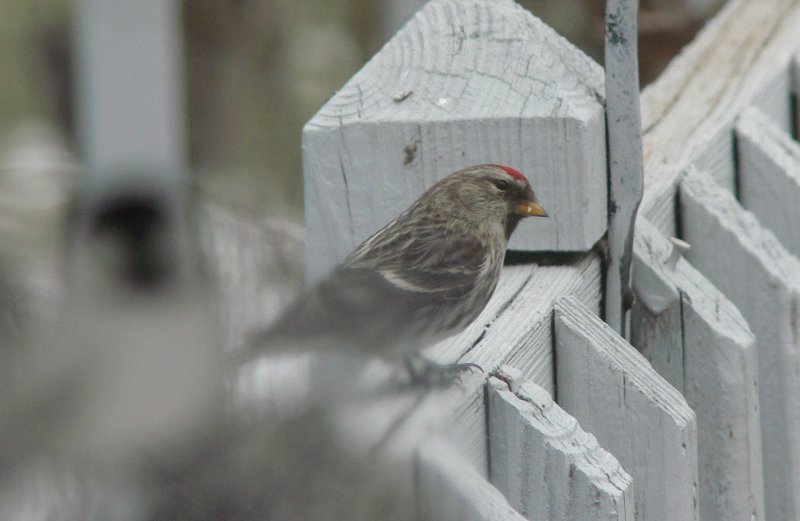
“Greater” or “Greenland” Common Redpoll (Acanthis flammea rostrata), 20 Dec 2007 in Millbury, Worcester. Photo by Dan Berard.
NOT ACCEPTED RECORDS
Pacific Loon (Gavia pacifica)
Loon identification is often complicated by variable plumage dependent on season and age as well as by the vast distances that typically separate the observer from the loon. Thus the Committee takes a conservative stance on reports that do not include all field marks. Both these reports were of distant birds on open ocean: one at Marconi Beach, Wellfleet, Barnstable, January 12, 2008 (2008-02), and a basic-plumaged bird at Lot 1, Plum Island, Essex, June 4, 2008 (2008-16).
Western Grebe (Aechmophorus occidentalis)
Two records were reviewed and not accepted: one at Marconi Beach, Wellfleet, Barnstable, January 12, 2008 (2008-02), and two birds at Revere Beach, Suffolk, October 12, 2008 (2008-31). The Barnstable bird was seen distantly and submitted by a single observer. The Suffolk birds were seen initially at a distance, and the observers were unable to relocate them after attempting to move closer. Although a majority of the Committee voted to accept the Revere Beach record, four members were concerned that perhaps the observers were mistaken in their initial, more distant views, especially because Western Grebes only rarely take flight and should have been easy to relocate. Some Committee members also noted the date, which was about a month earlier than any other report for Massachusetts; almost all Western Grebes on the East Coast have been seen from mid-November to mid-May.
American Flamingo (Phoenicopterus ruber)
Two historical records of American Flamingo were considered this year. One at Plum Island, Essex, September 16–October 25, 1964 (ph. observer unknown; 1964-02), and another at Natick, Middlesex, in August 1964, or more likely May 20, 1965 (Bagg and Emery 1965), were both accompanied by photographs (ph. observer unknown; 1964-03). The Committee took three rounds to agree that species identification indeed pertained to the North American form, which was separated as a species from the Old World Greater Flamingo (Phoenicopterus roseus) in 2008 (Banks, et al. 2008). Once identification was established, the thorny issue of provenance was considered, because American Flamingos have been kept somewhat frequently in collections. Evidence relating to the Natick bird strongly suggested that it was an escapee, because one of two birds imported from the Dominican Republic by a nearby Westwood resident had escaped prior to the sighting (Bagg and Emery 1965). The Natick record was unanimously considered in the third round to be of non-natural provenance. The Plum Island bird had no clear connection to the Westwood incident, and garnered two votes to accept, but the majority was concerned that the date, location, and dull plumage of the bird were not suggestive of natural origin. Some stray flamingos have been treated as wild by Records Committees along the East Coast; for example, an adult photographed at Assateague Island, Worcester, MD, late June–September 3, 1972 (Rowlett 1972), was accepted as wild by the MD/DCRC (Davis 2005), in part due to its appearance after Hurricane Agnes. Similarly, many other records away from areas of regular occurrence in the Bahamas, southernmost Florida, and the Yucatan, have been tied to the passage of hurricanes (McNair and Gore 1998). In contrast, the two Massachusetts records from the mid-1960s were not tied to tropical storms.
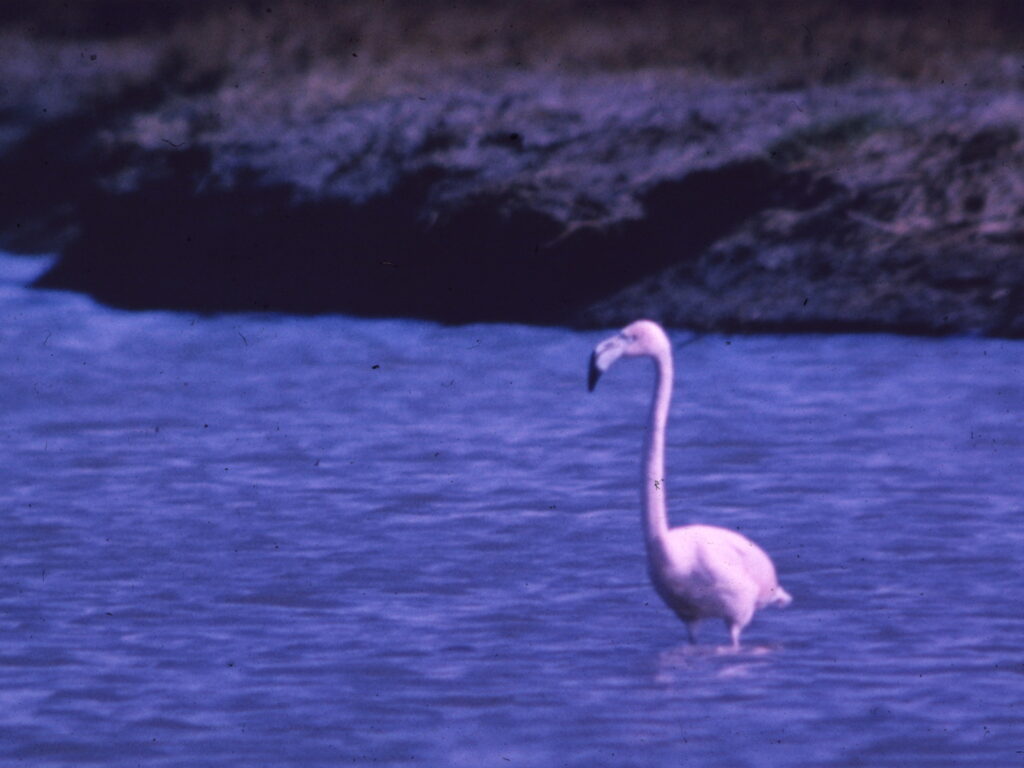
American Flamingo, Plum Island, Essex, 16 Sep 1964. Photographer unknown.
Brown Booby (Sula leucogaster)
One seen for a second or two while sea watching in the wake of Hurricane Hanna at Manomet Point, Manomet, Plymouth, on September 7, 2008 (2008-40), garnered no committee support. Concerns centered on the species’ rarity (three previous state records) and the extremely brief view.
Eurasian Kestrel (Falco tinnunculus)
The Committee was not convinced by a brief, single-observer description of a flyby Eurasian Kestrel at Lot 1, Plum Island, Essex, April 13, 2009 (2009-12). Other observers present apparently did not see the bird well enough to identify it, and the extreme rarity of this species in the New World (e.g., Pranty, et al. 2004) was surely a factor in its non-acceptance. A single Committee member did endorse the description.
Black-tailed Gull (Larus crassirostris)
One reported by a lone observer at Little Nahant, Nahant, Essex, on October 18, 2007 (2007-43), was contentious for the Committee, requiring three rounds before a final decision in which only one member voted to accept the record. The observer described a medium-sized gull with a dark gray mantle, yellow legs, yellow bill with a black ring and red “lipstick” at the tip, and a white tail with a black terminal band. However, the view was brief and the bird was not relocated. Because of the extreme rarity of the species (there are only two Massachusetts records), the Committee members held this report to a very high standard. Although no plumage of a Lesser Black-backed Gull should combine a solidly gray mantle without brown and a black subterminal band, some Committee members expressed concern that the described field marks did not comprehensively eliminate that species.
Thayer’s Gull (Larus thayeri)
Identification of Thayer’s Gull is extremely difficult and subject to interpretation, especially because “Kumlien’s” Iceland Gull is so variable and can cause confusion. For this reason, the Committee did not accept two records that were submitted without photos, single first-winters at Eastern Point, Gloucester, Essex, January 13, 2009 (2009-13), and January 18, 2009 (2009-14).
South Polar Skua (Stercorarius maccormicki)
Not only is separation of South Polar Skua from Great Skua (Stercorarius skua) one of the most serious field identification challenges in New England, but also young Pomarine Jaegers (Stercorarius pomarinus) have been mistaken for skuas with regularity, even by experienced birders. The description of this bird from Stellwagen Bank, off Provincetown, Barnstable, October 3, 2007 (2007-38), left eight members unconvinced that it might not be either a Great Skua or a Pomarine Jaeger. Furthermore, several members noted that October would be remarkably late for a South Polar Skua.
Northern Hawk Owl (Surnia ulula)
The Committee received photographs showing a Northern Hawk Owl that was reported to have been in a yard in Millbury, Worcester, late in the evening on February 7, 2008, and again early in the morning of February 8, 2008 (2008-07). Multiple observers present on the latter date failed to relocate the bird. Although there was no doubt that the photos submitted showed a Northern Hawk Owl, certain aspects of both the written and photographic documentation prompted a follow-up with the original observer. The observer ultimately conceded that one of the photographs had been taken in Canada years prior but was nonetheless submitted as documentation for a sighting from Millbury. Although the observer apologized for the dishonest report, the Committee was left with too many questions to endorse this single-observer sighting, and it failed unanimously.
MacGillivray’s Warbler (Oporornis tolmei)
A MacGillivray’s Warbler reported from Dunback Meadow, Lexington, Middlesex, September 6, 2008 (2008-24), was very nearly accepted, garnering support from six of nine members on its third round. Although views were brief, the observer described the distinctive smacking call note, broad eye arcs above and below the eye, and gray head color extending to the throat. The three members with reservations noted that despite the 14 records in Massachusetts, MacGillivray’s remains a very rare bird on the East coast with just eight records outside of Massachusetts, most in October to December. The brief views (of only two seconds), which did not allow study of tail length or underside, were also mentioned by the three dissenters, although all acknowledged that the experienced observer and details provided strongly suggested a correct identification.
Hoary Redpoll (Acanthis hornemanni)
Separation of Hoary Redpoll from Common Redpoll (Acanthis flammea) is to be approached with extreme caution. Although photos accompanied a report from Cummington, Hampshire, on January 5, 2008 (2008-08), and although the sighting occurred during a known flight year when other Hoaries were present in the state, the Committee erred on the conservative side with three members voting not to accept. Given the largish bill, some felt the bird in the photos was more likely a pale Common Redpoll. Six members felt strongly that the identification was correct, illustrating just how difficult this identification can be, particularly when the images do not show the bird from a sufficient range of angles. Especially important to capture is undertail-covert pattern, bill shape from multiple points of view, back color, and breast and flank pattern.
References:
AB = American Birds; BO = Bird Observer; NAB = North American Birds
American Birding Association. 2008. ABA Checklist, 7th ed. Colorado Springs, CO: American Birding Association.
American Ornithologists’ Union [A. O. U.]. 1957. Check-List of North American Birds, 5th ed. Baltimore, MD: Port City Press.
American Ornithologists’ Union. 1998. Check-List of North American Birds, 7th ed. Lawrence, Kansas: American Ornithologists’ Union..
Bagg, A.M. and R.P. Emery. 1965. Spring Season 1965: Northeastern Maritime Region. Audubon Field Notes 19(4): 450.
Banks, R.C., R.T. Chesser, C. Cicero, J.L. Dunn, A.W. Kratter, I.J. Lovette, P.C. Rasmussen, J.V. Remsen, Jr., J.D. Rising, D.F. Stotz, and K. Winker. 2008. Forty-ninth Supplement to the American Ornithologists’ Union Check-list of North American Birds. Auk 125: 758–768.
Beetz, J. 1916. Notes on the Eider. Auk 33: 286–292.
Bull, J. 1974. Birds of New York State. Garden City, NY: Doubleday/Natural History Press, [reprinted Cornell Univ. Press, Ithaca, NY, 1985]
Chalif, E. 1947. Northern Eider on Martha’s Vineyard. Auk 64: 633
Chesser, R. T., R. C. Banks, F. K. Barker, C. Cicero, J. L. Dunn, A. W. Kratter, I. J. Lovette, P. C. Rasmussen, J. V. Remsen, Jr., J. D. Rising, D. F. Stotz, and K. Winker. 2009. Fiftieth Supplement to the American Ornithologists’ Union Check-List of North American Birds. Auk 126(3): 705–714.
Davis, Phil. 2005. Maryland/DC Records Committee Status Report as of March 29, 2005. The Maryland Yellowthroat 25(3): 16–17.
Goudie, R. I., G. J. Robertson, and A. Reed. 2000. Common Eider (Somateria mollissima). No. 546 in The Birds of North America (A. Poole, and F. Gill, eds.). Philadelphia, PA: The Birds of North America, Inc. 32 pp. http://bna.birds.cornell.edu.bnaproxy.birds.cornell.edu/bna/species/546
Griscom, L. 1937. European Dunlins in North America. Auk 54: 70–72.
Griscom, L., and D. E. Snyder. 1955. The Birds of Massachusetts. An Annotated and Revised Check List. Salem, MA: Peabody Museum.
Howell, S. N. G. and J. Brian Patteson. 2008. Variation in the Black-capped Petrel – One Species or More? Alula 2-2008: 70–83.
Johnsgard, P. A. 1979. Order Anseriformes. Check-list of Birds of the World. vol. 1, 2nd ed. (Mayr, E. and G. W. Cottrell, eds.) Cambridge, MA: Museum of Comparative Zoology 425–506.
Kaplan, J. and G. Hanisek. 2008. Thirteenth Report of the Avian Records Committee of Connecticut. The Connecticut Warbler 28(1): 10–11.
Knapton, R. W. 1997. Identification of Female Common Eider Subspecies in Canada. Birders Journal 6: 134–136.
Langridge, H. P. and G. Hunter. 1993. Probable Sighting of a Brown-chested Martin in Palm Beach County, Florida. Florida Field Naturalist 21: 18–19.
Lehman, P. 1998. Brown-chested Martin in Cape May! First New Jersey and Second Documented North American Record. Records of New Jersey Birds 24: 66–69.
McNair, D.B. and J.A. Gore. 1998. Assessment of Occurrences of Flamingos in Northwest Florida, Including a Recent Record of Greater Flamingo (Phoenicopterus ruber). Florida Field Naturalist 26: 40–43.
Mendall, H.L. 1980. Intergradation of Eastern American Common Eiders. Canadian Field-Naturalist 94: 286–292.
Mendall, H.L. 1986. Identification of Eastern Races of the Common Eider. Eider Ducks in Canada. Canadian Wildlife Service Report Series Number 47, A. Reed, ed. Ottawa, ON, Canada: 82–88.
Petersen, W. 1995. First Report of the Massachusetts Avian Records Committee. Bird Observer 23(5): 263–274.
Petersen, W. 1998. Third Report of the Massachusetts Avian Records Committee. Bird Observer 26(6): 276–284.
Petersen, W.R., B.J. Nikula, and D.W. Holt. 1986. First Record of Brown-chested Martin for North America. AB 40: 192–193.
Perkins, S. 1998. New England Region. Audubon Field Notes 52: 304.
Perkins, S. 2009. Spring Season — New England. NAB 63: 391–397.
Pranty, B., E. Kwater, H. Weatherman, and H.P. Robinson. 2004. Eurasian Kestrel in Florida: First Record for the Southeastern United States, with a Review of its Status in North America. NAB 58: 169–169.
Ridgely, R. S., and J.A. Gwynne Jr. 1989. A Guide to the Birds of Panama. Princeton, NJ: Princeton University Press.
Rines, M. 2002. Sixth Report of the Massachusetts Avian Records Committee. Bird Observer 30(2): 113–118.
Rines, M. 2006. Tenth Report of the Massachusetts Avian Records Committee. Bird Observer 34(2): 91–99.
Rines, M. 2007. Eleventh Report of the Massachusetts Avian Records Committee. Bird Observer 35(2): 73–80.
Rines, M. 2009. Thirteenth Report of the Massachusetts Avian Records Committee. Bird Observer 37(2): 85–101.
Rowlett, R.A. 1972. A “Wild” Flamingo in Maryland? Maryland Birdlife. 28: 148–49.
Roberts, P. 2009. The March of Ross’s Goose. Bird Observer 37: 137–146.
Scott, P. 1957. A Coloured Key to the Wildfowl of the World. Slimbridge: The Wildfowl Trust.
Stevenson, H.M., and B.H. Anderson. 1994. The Birdlife of Florida. Gainesville, FL: University of Florida Press.
Veit, R.R., and W.R. Petersen. 1993. Birds of Massachusetts. Lincoln, MA: Massachusetts Audubon Society.
West, G. C., L.G. Peyton, and S. Savage. 1968. Changing Composition of a Redpoll Flock. Bird Banding 39: 51–55.
